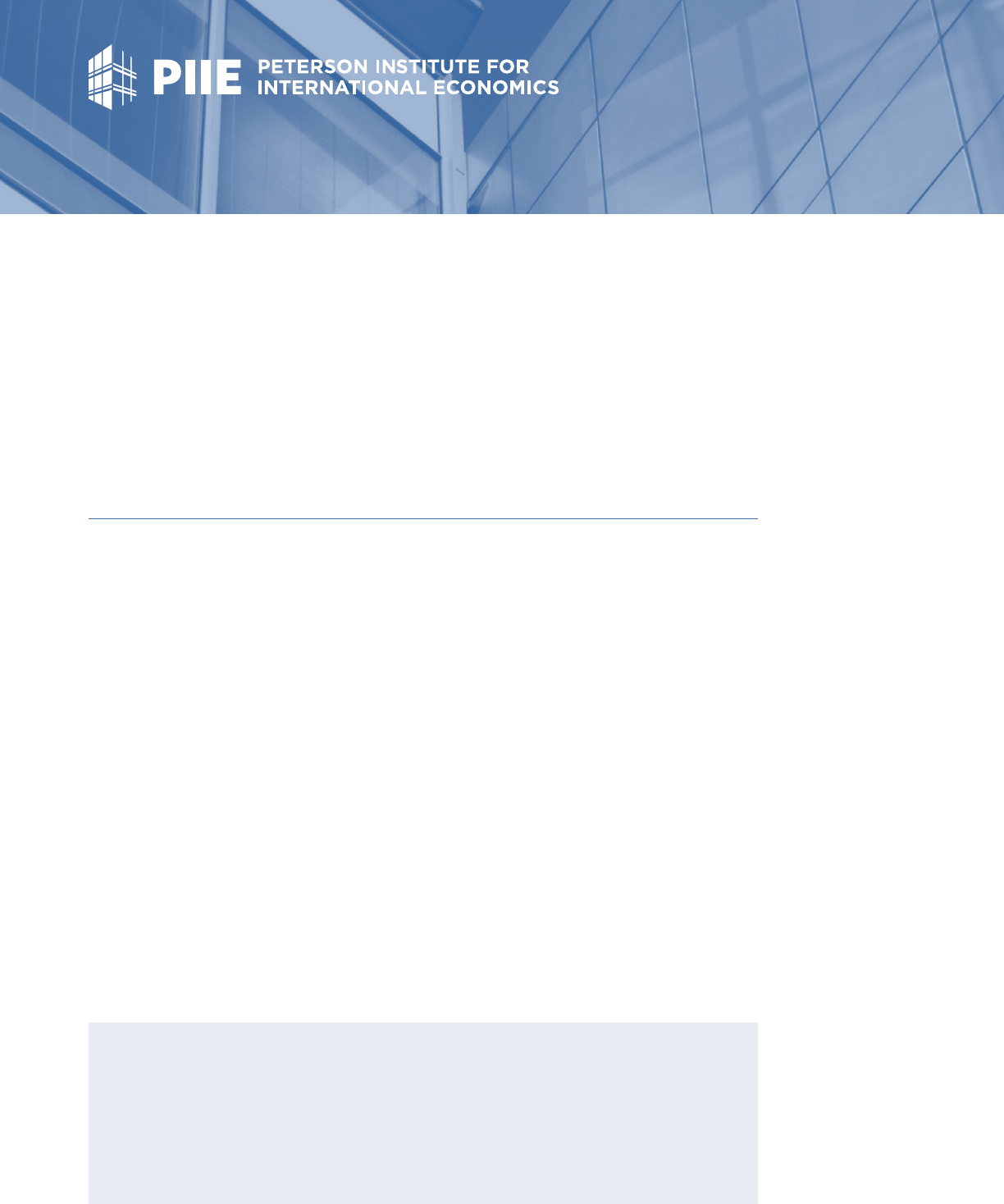
1750 Massachusetts Avenue, NW | Washington, DC 20036-1903 USA | +1.202.328.9000 | www.piie.com
WORKING PAPER
24-2 Trade policy, industrial policy,
and the economic security of
the European Union
Chad P. Bown
January 2024
ABSTRACT
Out of fear about its economic security, the European Union is transitioning to a
new form of international economic and policy engagement. This paper explores
some of the major trade issues surrounding the bloc’s economic security, the role
of trade and industrial policy in achieving its objectives, and some of the economic
costs of doing so. It begins by explaining why economic security is suddenly playing
such a prominent role and providing early evidence to motivate these government
interventions. It then turns to a case study—new policies associated with China’s
exports of electric vehicles and graphite—that highlights the difficult choices and
practical challenges the European Union faces in tailoring policy to address concerns
over economic security. The paper then introduces the domestic policy instruments
that the European Union, its member states, and other governments are pursuing
to address economic security, including stockpiling and inventory management,
investment or production subsidies, tariffs, export controls, and regulations on
foreign investment, as well as the scope for selective international cooperation over
such policy instruments. The paper concludes with some caveats about abandoning
interdependence and lessons from history.
JEL codes: F13, L52
Keywords: Economic security, supply chains, industrial policy, trade policy, tariffs,
subsidies, export controls
Author’s Note: A revised version of this paper is forthcoming in an ITCEI Report by
CEPR. For helpful conversations and feedback, the author thanks Panle Jia Barwick,
Olivier Blanchard, Heather Grabbe, Gene Grossman, Wonhyk Lim, Niclas Poitiers, Michele
Ruta, Reinhilde Veugelers, Beatrice Weber, Jeromin Zettelmeyer, and participants at the
CEPR Paris Symposium 2023. Thanks to Jing Yan for outstanding research assistance;
Nia Kitchin and Alex Martin for assistance with graphics; and Barbara Karni and Madona
Devasahayam for editorial assistance.
Chad P. Bown is the
Reginald Jones Senior
Fellow at the Peterson
Institute for International
Economics.

2 WP 24-2 | JANUARY 2024
“This is why—after de-risking through diplomacy—the second strand of our
future China strategy must be economic de-risking. The starting point for this is
having a clear-eyed picture on what the risks are.”
—Ursula von der Leyen, President of the European Commission,
March 30, 2023
1. INTRODUCTION
Out of fear about its economic security, the European Union is transitioning
to a new form of international economic and policy engagement. The Trump
administration in the United States, Russia’s invasion of and war on Ukraine, and
concerns over China’s increasingly aggressive foreign and economic policies have
combined to put a new EU policy into motion. Without the assurance that other
countries will continue to follow the rules of a multilateral trading system, the
European Union is working through what comes next.
1
It is taking steps to rebalance its position in the global economy. While
seeking to preserve the benefits of interdependence with the rest of the world,
the European Union is contemplating policies that would induce change. One
change seeks to alter the footprint of global production for certain goods,
affecting whom it sources imports from and whom it sells exports to. It wants to
decrease certain trade dependencies (which could be weaponized) and increase
others (to encourage diversification). A second change is the enactment of new
contingent policy instruments intended to allow the European Union to respond
more quickly when policymakers in other countries act badly (or to establish a
credible threat sufficient to deter them from doing so in the first place).
This paper describes how the European Union is seeking to use trade and
industrial policy to achieve its economic security objectives. It identifies some
of the economic costs and tradeoffs of using such policies. Because the issues
it examines—many of which are noneconomic, for which reasonable estimates
of costs and benefits are lacking—are evolving, the paper shies away from
normative recommendations. Instead, it explores the political economy of what
is emerging and why. The paper focuses on EU efforts to “de-risk” vis-à-vis China
especially, given the emphasis EU policymakers now place on doing so.
The paper is organized as follows. Section 2 defines the concept of economic
security and the events that led it to play such a sudden and prominent
role in modern policy.
2
It provides some early evidence to motivate the new
policy interventions but emphasizes that much remains unknown, especially
concerning their design.
Section 3 explores a case study that highlights the difficult choices the
European Union faces in responding to threats to its economic security. The
case study involves the electric vehicle (EV) industry, the European Union’s
potential use of trade defense instruments (TDIs) to address unfairly subsidized
1 See European Commission (2023a).
2 Other treatments touching on some of the aspects of economic security introduced here
include Hoekman, Mavroidis, and Nelson (2023) and Pinchis-Paulsen, Saggi, and Mavroidis
(forthcoming). Paulsen (2023) presents a legal treatment from the perspective of historical
trade negotiations.

3 WP 24-2 | JANUARY 2024
imports from China, and China’s potential retaliatory response of placing export
restrictions on graphite, a critical material needed to manufacture EV batteries.
It also identifies unknowns facing policymakers seeking “a clear-eyed picture on
what the risks are,” in the words of European Commission President Ursula von
der Leyen. The section also explores empirically whether the European Union’s
trade interdependence with China may be deepening—despite stated goals
to de-risk—in part because of the third-country effects arising from the US–
China trade war.
Section 4 introduces the policy instruments the European Union, its member
states, and other governments are pursuing to address concerns about their
economic security. They include stockpiling and inventory management,
investment or production subsidies, various forms of tariffs, export controls, and
regulations on foreign investment. This section also highlights proposals for new
policy instruments, analyzes the associated tradeoffs, and briefly describes basic
World Trade Organization (WTO) rules that might discipline such instruments.
Section 5 turns to the potential for selective international cooperation over
the use of such policy instruments. It explores how countries facing common
concerns over economic security have been acting in coordinated fashion—
implicitly or explicitly—and the difficulties of doing so.
Section 6 concludes with some caveats and lessons from history.
2. THE MODERN POLICYMAKER CONCERN OVER ECONOMIC SECURITY
2.1 What is economic security?
Economic security at the national level is still an emerging concept.
3
At a
minimum, it involves a country getting the goods and services it needs when it
needs them, at a reasonable price, with an acknowledgment that its economy is
open and has some interdependence with the outside world. The nascent field
of economic security shares similarities with national security, which Murphy and
Topel (2013, 508) define as “the set of public policies that protect the safety
or welfare of a nation’s citizens from substantial threats.”
4
Modern concerns
over economic security, however, involve recognition that others—typically
policymakers abroad—may be working against a country’s effort to achieve
its objectives.
Policymakers might work at cross-purposes to another country’s interests for
a variety of reasons, economic and noneconomic. For example, a large (price-
shifting) exporting country might impose export restrictions or a nationally
optimal export tax in order to shift the terms of trade in their country’s favor
if the national benefits of the price change are larger than the efficiency costs
3 In the poverty literature, economic insecurity at the individual level is relatively well defined,
with a variety of measures and data informing policymakers on economic well-being.
4 On national security (NS), Murphy and Topel (2013, 508) write, “While NS policies are typically
thought of in terms of military assets, our definition includes the development and deployment
of any public good that would mitigate catastrophic outcomes for a large segment of the
population.”

4 WP 24-2 | JANUARY 2024
associated with the economic distortions it causes.
5
Domestic policymakers
might give in to political pressure to impose a policy that benefits one local
group (consumers) at the expense of another (firms/exporters); if the country is
large, the policy could have unintended effects abroad.
6
Foreign policymakers
could also be concerned about the relative sizes of two economies—which affect
the ability to wage war—and therefore want to slow the other country’s economic
growth. They might be seeking to achieve a more targeted, albeit noneconomic
objective (i.e., curtailing another country’s access to a good or service that
improves its military capabilities and threatens the other country’s national
security). Or they could be seeking to influence political outcomes abroad toward
a leader more sympathetic to their country’s interests.
This concept of economic security expands the scope of the nascent
literature on supply chain resilience, which examines other important shocks—
climate change, public health emergencies, natural disasters—that could be
transmitted from one country to another through interdependent supply chains.
By including resilience to actions by malicious policymakers abroad, economic
security also recognizes that foreign governments may adopt noncooperative
policies and that a strategic setting is in play.
7
The European Commission, some EU member states, the US government,
and academics have begun to develop criteria to help policymakers. The initial
approach involved efforts to define an ex ante basket of goods and services
that are necessary for economic security and for which countries have import
dependencies that might be vulnerable.
8
Mejean and Rousseaux (forthcoming), for example, use detailed trade
data to build on the European Commission’s “bottom-up” approach to assess
EU vulnerabilities.
9
To the extent possible, they also include information on
the European Union’s domestic supply capabilities, in order to assess the
ability of EU consumers to substitute away from imports if necessary toward
domestic production. They propose refinements to earlier lists of potentially
vulnerable products by also considering the type of risk government policy
is supposed to address. For example, policymakers might be more worried
about the vulnerabilities of products that are essential for human health and
have public good qualities, such as personal protective equipment (PPE) and
vaccines, than they are about products for which the main concern is economic
competitiveness.
5 This dimension is not the only one along which interdependence could be exploited. A
large importing country could impose tariffs. A country with large state-owned enterprises
could allocate its foreign direct investment flows in ways that benefit them. On the role of
international trade agreements such as the WTO in handling the international externalities
associated with policy changes, see Bagwell and Staiger (1999, 2002).
6 India, for example, periodically imposes export restrictions on onions, in order to limit domestic
price increases for a staple food. It responded to the sudden surge in domestic COVID-19
infections in 2021 by banning exports of COVID-19 vaccines from the Serum Institute for six
months (Bown and Bollyky 2022).
7 Even if markets are competitive for firms, countries may still be “large,” in that governments
can use border policies (import or export restrictions) to exert market power by influencing
the terms of trade and thus act strategically vis-à-vis actors in other countries.
8 See European Commission (2020, 2021); White House (2021); Bonneau and Nakaa (2020); and
Jaravel and Mejean (2021).
9 See also Baur and Flach (2022) and Vicard and Wibaux (2023).

5 WP 24-2 | JANUARY 2024
Such trade dependency approaches have their limitations, however, because
of deficiencies in the data available to policymakers. For example, information
on the foreign source of imports may be available at a detailed (product) level,
but the same level of aggregation is not typically available for foreign production
or for input–output relationships involving foreign supply chains. (The graphite
example presented below is one illustration of this potential limitation.) The
European Union can be exposed indirectly: A disruption in country B can hurt
EU imports from country A because A is dependent on imported inputs from
B. Policymakers may not be able to observe this dependency, because it arises
through input choices made by firms in country A in order to sell a good or
service to the European Union.
10
Policymakers also need more information about the responsiveness time
horizon. Beyond whether and how costly it is for EU consumers to find an
alternative production source, policymakers want to know how quickly such a
switch can materialize. This issue has taken on increased salience since product
shortages developed during the pandemic and Russia’s war on Ukraine.
11
A final
open question involves whether dependencies have the potential to shift more
quickly and with less warning (to outsiders) when a major trading partner is a
state-centric nonmarket economy. Is trade dependency on China, for example,
riskier than dependency on some other country because China is more likely to
use industrial policy and to do so through opaque means that make such shifts
difficult for outsiders to observe and respond to?
2.2 How did we get here?
Three main factors explain why economic security suddenly became such a
concern for policymakers: the success of the international trading system at
achieving some outcomes, its failure at achieving others, and the suddenly
changing world.
For decades, major industrial economies like the European Union and United
States largely got what they wanted out of the global system. Following the end
of World War II, they repeatedly gathered to negotiate reciprocal reductions
to tariff barriers. Low trade barriers combined with major technological
advancements (containerized shipping, the information and communications
technology [ICT] revolution, and managerial improvements) and peace after
the end of the Cold War (and China’s 1978 opening up) resulted in efficient and
often global supply chains. However, this efficiency also sometimes resulted in
the geographic concentration of production for certain goods and services that
these economies would come to regret once the world changed.
The global trading system failed elsewhere. China’s integration into the
global economy was phenomenally successful at lifting hundreds of millions
of its people out of poverty in less than four decades. But its integration was
also disruptive to people elsewhere, for reasons beyond the mere entrance of a
new trading partner forcing incumbent economies to adjust. China’s failure to
10 For an application to US supply chain exposure to China, see Baldwin, Freeman, and
Theodorakopoulos (forthcoming).
11 For an examination of the average duration of firm-to-firm purchasing relationships as a proxy
for responsiveness to shocks, see Martin et al. (forthcoming).

6 WP 24-2 | JANUARY 2024
transition to a market economy, its use of industrial policy, its deployment of
export restrictions and targeted acts of economic coercion, and the inability of
trading partners to turn to the WTO to do much about it led US political leaders
in particular to perceive that the WTO system had failed. There would be no
quick fixes, as a design flaw meant that the WTO lacked a legislative function to
change its rules in ways that would allow the system to keep going. A result was
the US–China trade war, in which both countries violated WTO rules and norms,
and the withdrawal of US support of binding WTO dispute settlement.
12
The third factor explaining the new emphasis on economic security is the
suddenly changed world. The distribution of political-economic shocks has
changed in ways that challenge the optimality of the existing location of global
production. For certain goods, manufacturing has been deemed excessively
concentrated geographically. Climate change has increased the frequency and
severity of storms and droughts, leading to extreme events ranging from floods
to wildfires. The COVID-19 pandemic woke the world up to the frightening
possibility of sudden public health emergencies that could lead to lockdowns
affecting production, snarled transportation and logistics, and wild swings in
demand. These shocks raised concerns about supply chain resilience, which are
arguably more economic (than geopolitical) in nature.
Geopolitics is the last important change to the distribution of shocks; it is
also the factor that differentiates economic security from simple supply chain
resilience.
13
Geopolitics means that a foreign policymaker may actively work to
reduce the economic security of another economy. From the European Union’s
perspective, three major changes to geopolitics are worth highlighting.
The first was the shock over the presidency of Donald J. Trump. Trump bullied
the European Union, supported Brexit, and sought to undermine European
institutions.
14
By threatening to withdraw the United States from NATO, he
put decades of European military security at risk.
15
On trade policy, he ended
up imposing tariffs only on European steel and aluminum, an action not that
different in terms of its economic magnitudes from what the George W. Bush
administration did in 2002. However, the US relationship with Europe soured
when he claimed that those metal imports from the European Union threatened
America’s national security and when he further threatened additional tariffs on
imports of European cars. His administration ended US support for the WTO,
a problematic step given that the multilateral system forms the institutional
foundation for the European Union’s trade relationship with the world. Then,
under Trump’s 2020 Phase One agreement, China was supposed to purchase
additional US exports, even if they came at the expense of exports from
Europe and other countries.
16
(These purchases never happened, as described
12 On the US–China trade war, see Bown (2021). On the United States and WTO dispute
settlement, see Bown and Keynes (2020).
13 For one formal modeling approach, see Clayton, Maggiori, and Schreger (2023).
14 See Matthew Rosenberg, Jeremy W. Peters, and Stephen Castle, “In Brexit, Trump Finds a
British Reflection of His Own Political Rise,” New York Times, July 13, 2018.
15 Julian E. Barnes and Helene Cooper, “Trump Discussed Pulling US From NATO, Aides Say amid
New Concerns over Russia,” New York Times, January 14, 2019.
16 See Chad P. Bown, Unappreciated Hazards of the US–China Phase One Deal, PIIE Trade and
Investment Policy Watch, January 21, 2020.

7 WP 24-2 | JANUARY 2024
below.) The election of Joseph R. Biden restored many—though not all—of the
pre-Trumpian features of the transatlantic alliance, but the fear of a return by
President Trump in 2024 never receded from European view.
17
The second and most important geopolitical event for Europe was Russia’s
invasion of Ukraine. The move exacerbated Russia’s deteriorating relationship
with Europe and other Western economies, which began to sour following
Russia’s 2014 annexation of Crimea. In 2022, Russia weaponized its exports by
withholding sales of natural gas to Europe through the Nord Stream 1 pipeline.
Prices spiked, contributing to inflation, stoking political problems across Europe,
and causing immediate-term economic concerns for the competitiveness of
energy-intensive industries, especially in Germany.
Europe’s third geopolitical concern involves China. Under President Xi
Jinping, China has become much more aggressive toward its neighbors,
threatening the security of major shipping lanes through the East and South
China Seas. It has widened its use of economic coercion by cutting off trade to
punish countries whose foreign policy it disagrees with, including Lithuania for its
diplomatic ties with Taiwan and its opening a “Taiwan Representative Office” in
Vilnius.
18
(There is also increasing worry that China may seek to retake Taiwan by
force.) Finally, in response to EU sanctions over human rights violations related
to the mass detention and persecution of Uyghurs in Xinjiang, China imposed
counter sanctions, including on members of the European Parliament.
2.3 Is a policy needed, or are firms adjusting on their own?
An important motivating question is whether policy is needed. Perhaps these
shocks are not systematically affecting economic activity or firms are already
internalizing the fact that the world is changing and adjusting their decisions
even in the absence of new government policy.
There is evidence that some of these shocks have adversely affected firms
and supply chains. While many of the shocks are new and have therefore not yet
been fully examined, the evidence to date is that shocks have had the expected
impacts. Consider, for example, the earthquake that led to the tsunami and
nuclear incident at Fukushima, Japan in 2011. Boehm, Flaaen, and Pandalai-
Nayar (2019) find that the decline in US manufacturing output resulting from
Japanese affiliates that were unable to import because of the shock was sizable.
Lafrogne-Joussier, Martin, and Mejean (2023) study the behavior of French firms
in response to the early days of the COVID-19 lockdowns in China. They find that
French firms sourcing inputs from China saw imports fall by more than firms
sourcing from elsewhere and that those firms subsequently experienced a larger
drop in domestic sales and exports. In terms of mitigation strategies, geographic
diversification did not appear to help, but firms with larger inventories did seem
to weather the shocks better than other firms did.
17 See Andrew Gray and Charlotte Van Campenhout, “Trump Told EU That Us Would Never Help
Europe under Attack: EU Official,” Reuters, January 10, 2024.
18 The Chinese government views Taiwan as part of China and that the island should not have
independent diplomatic relations with other countries. On the Lithuania incident, see Norihiko
Shirouzu and Andrius Sytas, “China downgrades diplomatic ties with Lithuania over Taiwan,”
Reuters, November 21, 2021.

8 WP 24-2 | JANUARY 2024
Early evidence about firms’ response to incentives about resilience is mixed.
Castro-Vincenzi (2022), for example, examines how the global automobile
industry adjusted to climate-related shocks. He finds that firms responded to the
increased incidence of extreme weather events (floods) by having more plants,
operating smaller plants, and holding some unused capacity at those plants,
in order to be able to smooth their global production over bad states of the
world. Khanna, Morales, and Pandalai-Nayar (2022) examine firms exposed to
the sudden shock of COVID-19 pandemic lockdowns in India. They find that firms
and their supply chains were adversely affected in the expected ways, but they
fail to find evidence that firms with more complex supply chains underperformed
those with simpler supply chains. One interpretation of this evidence is that firms
that know that they have complicated production chains invest in resilience ex
ante to mitigate shocks. However, in examining firms’ long-run response to the
Fukushima incident, Freund et al. (2022) find no evidence that they re-shored or
nearshored production or increased import diversification to mitigate risk. This
finding suggests that active policies may be needed to induce firms to diversify.
Even for the firms that may be responding to the heightened likelihood of
shocks by increasing their supply chain resilience, are they investing optimally
in resilience and, by extension, in security? Are they doing enough? Might
some be investing too much? New theoretical work has begun to explore the
market failures and externalities that might exist as well as the appropriate
policy intervention to create the right incentives. So far, this work suggests that
the answer is complex, nuanced, and highly dependent on the details of the
underlying supply chain and network.
19
Nevertheless, the European Union and
other countries are already changing policies, even if they are not being guided
by this research. The following sections explain how.
3. EUROPE’S TOUGH CHOICES INVOLVING ECONOMIC SECURITY
The European Union faces important choices and difficult tradeoffs. Its “open
strategic autonomy” approach suggests a wish to remain internationally
integrated with the outside world.
20
Although interdependence failed to prevent
Russia’s invasion of Ukraine, most of the evidence from the post–World War II
process of European integration is that it can be an important force for policy
moderation and peace. Although its perspective on China has become more
jaded, Europe does not see eye to eye with Washington. The differing views
partly reflect the fact that, unlike the United States, Europe is not bound by
treaty to uphold the military security of countries in Asia and the Pacific.
21
But
European positioning toward China also represents a hedge, as the bloc’s own
19 See Grossman, Helpman, and Lhuillier (forthcoming) and Grossman, Helpman, and Sabal
(2023).
20 European Commission Director General for Trade, Sabine Weyand, defined open strategic
autonomy as meaning “we act together with others, multilaterally, or bilaterally, wherever we
can. And we act autonomously wherever we must. And the whole of it adds up to the EU
standing up for its values and interests” (Bown and Keynes 2021a).
21 See Lindsey W. Ford and James Goldgeier, “Who Are America’s Allies and Are They
Paying Their Fair Share of Defense?” Brookings Commentary, December 17, 2019; US State
Department, “US Collective Defense Arrangements,” Archived Content, 2009–17.

9 WP 24-2 | JANUARY 2024
future relationship with the United States remains uncertain over fear of the
reelection of Trump, who has already proposed imposing a 10 percent tariff on all
imports, including imports from Europe.
22
At the same time, the European Union is facing increasing threats to its
economic security from China. This section illustrates them by examining
ongoing EU–China disputes over EVs, critical minerals, and materials needed to
manufacture batteries. It then explores the data, which, paradoxically, suggest
that not only is this case study not unique but that some of Europe’s trade may
be becoming more rather than less dependent on China, for reasons outside of
the control of European policymakers.
3.1 Is China weaponizing supplies and exports of electric vehicles, graphite
and critical minerals?
China has actively used industrial policy in a number of sectors, including its EV
supply chain.
23
One key element was a local content requirement for EV batteries,
introduced in 2016 and kept in place until 2019.
24
During this period, China’s
EV consumer subsidies were limited to automakers that used batteries on the
government’s “whitelist,” which included only local Chinese firms like BYD and
CATL, hurting Japanese and Korean battery manufacturers in particular.
Barwick et al. (in progress) provide evidence that as expected, China’s
discriminatory policy for EV batteries led to an increase in battery sales by BYD
and CATL. They also find, however, that because of learning-by-doing in the
downstream EV industry, China’s whitelist policy combined with EV consumer
subsidies (applied around the world) resulted in sharper EV price reductions
for vehicles using BYD and CATL batteries. The implication is that China’s
discriminatory local content policy for EV batteries indirectly provided downstream
Chinese EV manufacturers a further unfair advantage that worked like a subsidy.
25
China’s subsidies and industrial policy are likely contributors to the surge in
China’s EV exports into the European Union (figure 1). China’s industrial policy in
other sectors has proven concerning: In addition to the injury it caused to firms
in other markets, the subsidies can result in excessive firm entry, with inefficient
companies operating at insufficient scale. The current worry is that China’s
industrial policy for EVs will similarly result in excess capacity and the dumping
of its exports, including into the nascent European EV market.
26
22 See Jeff Stein, “Trump Vows Massive New Tariffs If Elected, Risking Global Economic War,”
Washington Post, August 22, 2023; Charlie Savage, Jonathan Swan, and Maggie Haberman,
“A New Tax on Imports and a Split from China: Trump’s 2025 Trade Agenda,” New York Times,
December 26, 2023.
23 China’s industrial policy for the EV supply chain follows a pattern that is similar to that in
industries such as shipbuilding, steel, aluminum, and solar panels. For new techniques to
identify, measure, and assess the impact of China’s industrial policy on shipbuilding, see
Kalouptsidis (2018) and Barwick, Kalouptsidi, and Zahur (forthcoming).
24 Qichao Hu, “In Honor of John B. Goodenough’s 100th birthday: What America Can Learn from
China’s Success in EV Batteries,” SES, July 22, 2022.
25 Barwick et al. (in progress) find that China’s industrial policy reduced EV sales globally relative
to a counterfactual without the whitelist policy. The intuition is that the Chinese policy shifted
sales from previously low-cost to high-cost suppliers, allowing inefficient firms to expand,
resulting in business-stealing from more efficient firms.
26 Joe Leahy, “EU Companies Warn China on EV Overcapacity,” Financial Times, September 19,
2023.
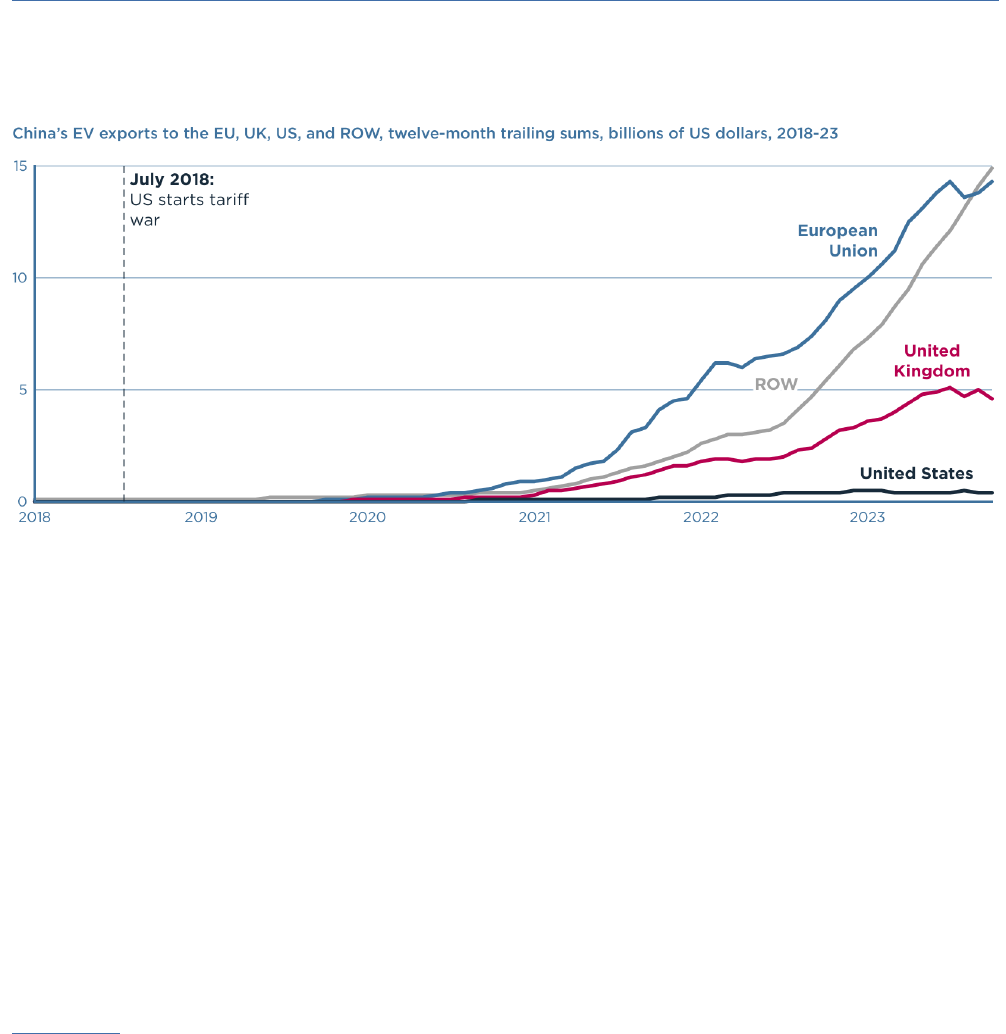
10 WP 24-2 | JANUARY 2024
Figure 1
Chinese exports of electric vehicles to the European Union have skyrocketed,
leading to an EU anti-subsidy investigation
ROW = rest of world; EV = electric vehicle
Source: Compiled by the author with data from UN ITC Trade Map and Chinese customs.
In October 2023, the European Commission announced an anti-subsidy
investigation into Chinese EVs that could result in countervailing measures
(tariffs).
27
The case faced a mixed response across Europe. The French
government welcomed the investigation,
28
in part because automakers like
Renault and Peugeot are direct competitors of lower-priced Chinese EV brands
like BYD and Polestar. Germany, whose automakers export some EVs from their
Chinese factories back to Europe, has been more circumspect,
29
concerned
about being caught up in the EU tariffs.
30
It is also worried about the potential
of Chinese retaliation through tariffs that could hit exports into China from
Germany’s European plants (more on this below) or that might go after the
German industry’s sizable investment in facilities in China.
China immediately responded to the European Commission’s investigation by
announcing new export restrictions on graphite (on “national security” grounds).
31
27 European Commission, “Commission Launches Investigation on Subsidised Electric Cars from
China,” Press release, October 4, 2023.
28 Reuters, “France’s Le Maire Welcomes EU Action against Chinese-Made Electric Cars,”
September 13, 2023.
29 Patricia Nilsson, Gloria Li, and Sarah White, “German Carmakers in the Line of Fire of Possible
EU–China Trade War,” Financial Times, September 19, 2023.
30 Siyi Mi, “EU Needs More Than Just Tariffs to Counter China’s Electric Cars,” Bloomberg,
September 28, 2023.
31 China’s Ministry of Commerce, “Announcement of the Ministry of Commerce and the General
Administration of Customs on Optimizing and Adjusting Temporary Export Control Measures
for Graphite Items,” October 20, 2023. China’s export curbs also likely target the United
States, Japan, South Korea, and other countries. They follow on new Chinese export curbs
on germanium and gallium, announced immediately after the Netherlands imposed export
controls on semiconductor manufacturing equipment, following the US lead (Qianer Liu and
Tim Bradshaw, “China Imposes Export Curbs on Chipmaking Metals,” Financial Times, July 3,
2023).
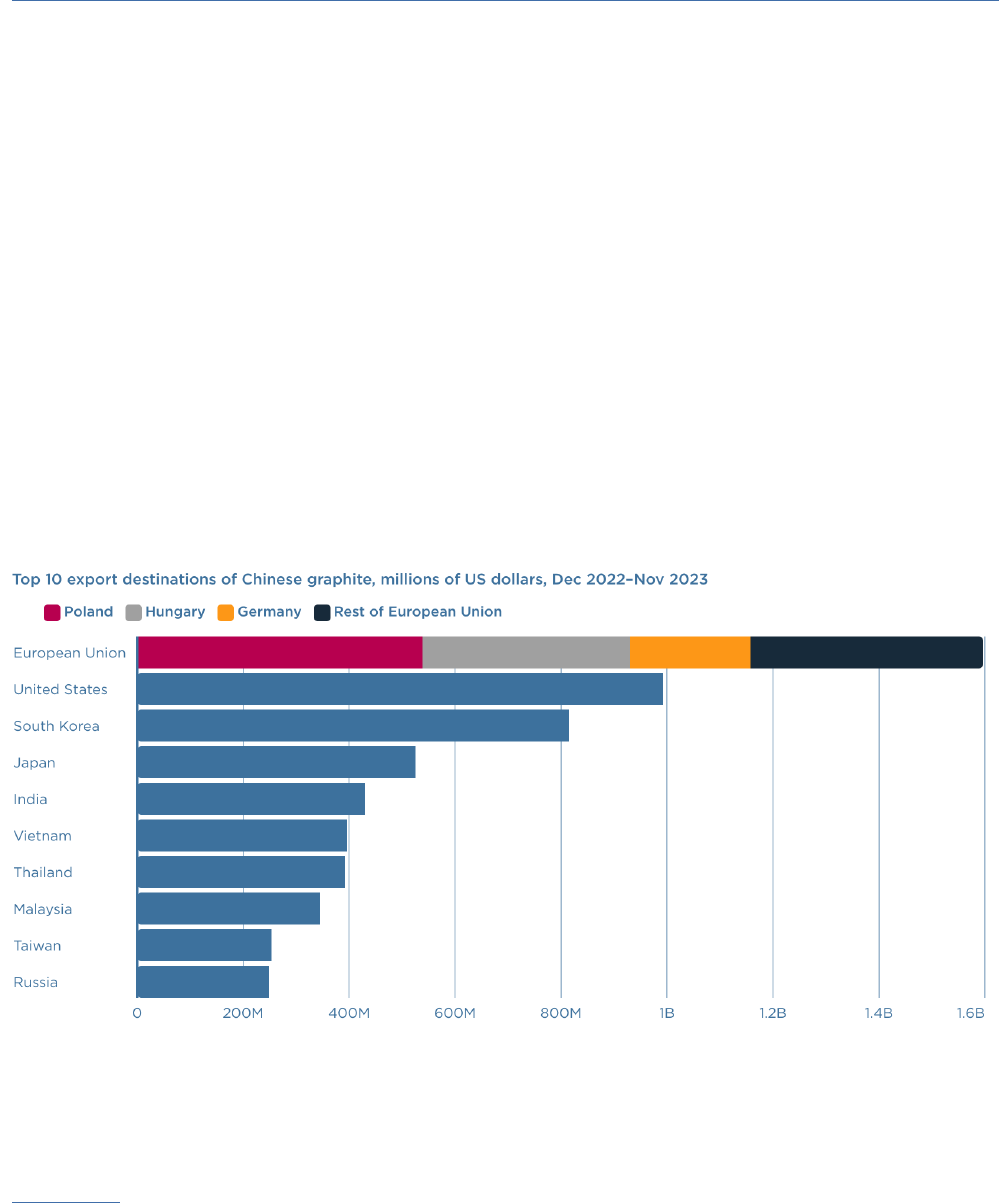
11 WP 24-2 | JANUARY 2024
It was not the first time China retaliated against an EU TDI, although in the past
it retaliated by imposing its own TDIs, as it did in response to EU measures on
steel fasteners (Bown and Mavroidis 2013) and X-ray equipment (Moore and Wu
2015); in response to EU measures on solar panels, China retaliated with a TDI
on upstream polysilicon.
32
(In January 2024, China did also respond to France’s
support for the Commission’s EV investigation with a new TDI action potentially
affecting French cognac.
33
)
Graphite is used to produce EV batteries. The European Union is the largest
importer of Chinese graphite subject to the new export restrictions (figure 2).
The three largest EU member state buyers of Chinese graphite exports are
Poland, Hungary, and Germany, home to some of the European Union’s largest
EV battery plants (figure 3). Chinese battery plants are coming online in Hungary
and Germany; other EV battery plants across the European Union are operated
by firms from Korea (Samsung SDI, SK Innovation, and LG Energy Solutions);
Japan (AESC); the United States (Tesla); and a host of European countries.
34
Figure 2
EU member states are large buyers of the Chinese graphite that China
suddenly announced would be subjected to export controls
Notes: HS codes 38011000; 38019090; 68151900; 25041010; 25041091; 38019010; 38249999. China’s
exports to rest of world were $1.4 billion (not shown).
Source: Compiled by the author with data from Chinese customs.
32 Michael Martina, “China Hits EU with Final Duties on Polysilicon,” Reuters, April 30, 2014.
33 Edward White, Adrienne Klasa, and Madeleine Speed, “China Targets French Brandy Imports in
Escalating Trade Dispute,” Financial Times, January 5, 2024.
34 Edward White, William Langley, and Harry Dempsey, “China Imposes Export Curbs on
Graphite,” Financial Times, October 20, 2023; Tom Philips, “Top Five: EV Battery Factories in
Europe,” Automotive IQ, April 21, 2020; Marton Dunai, Yuan Yang, and Patricia Nilsson, “The
Electric Vehicle Boom in a Quiet Hungarian Town,” Financial Times, November 29, 2022.
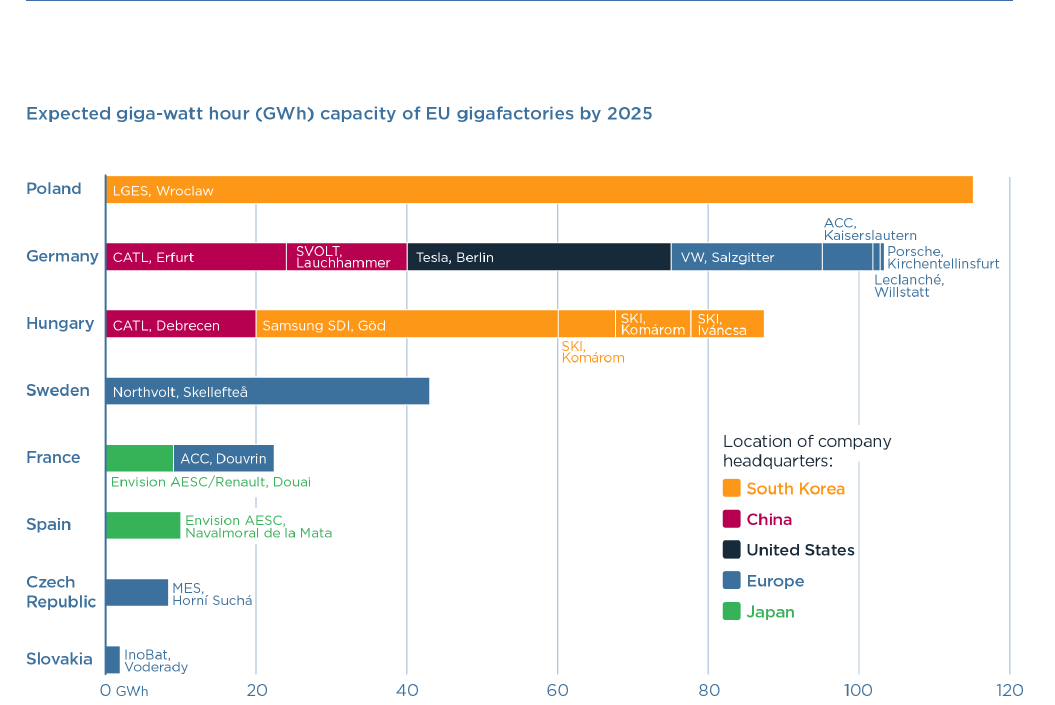
12 WP 24-2 | JANUARY 2024
Figure 3
Chinese battery manufacturers in Europe are clustered in Germany and Hungary
LGES - LG Energy Solutions; CATL = Contemporary Amperex Technology Co., Limited; SKI = SK Innovation;
VW = Volkswagen; AESC = Automotive Energy Supply Corporation; ACC = Automotive Cells Company; MES
= Magna Energy Storage
Notes: Announcements as of January 2024.
Source: Compiled by the author with data from Benchmark Mineral Intelligence.
What worries EU policymakers is how China chooses to implement these
graphite export restrictions. It could cut off all buyers located in Europe, harming
the EU battery industry and, by extension, EV manufacturing plants in Europe,
beyond the injury already inflicted by China’s subsidies and industrial policy for
batteries and EVs. Alternatively, China could allocate graphite export licenses
in a manner that differentiates between buyers within Europe. One approach
would be to allocate licenses in a way that drives a political wedge between
EU member states, in order to influence the outcome of Brussels’ anti-subsidy
investigation. Another would be to allocate licenses to benefit battery plants of
Chinese-headquartered firms in Europe, such as CATL, at the expense of non-
Chinese battery manufacturers in Europe. This strategy could have similar effects
as the 2016–19 whitelist policy, raising the question of whether China’s application
of differential export restrictions—which can work like a subsidy economically—
satisfies the legal definition of a subsidy and therefore justifies EU use of its new
Foreign Subsidies Regulation, discussed below.
The graphite example also helps illustrate the separate informational challenge
facing “clear-eyed” policymakers seeking to de-risk from China. Suppose forward-
looking EU policymakers examined the data to assess whether they should be
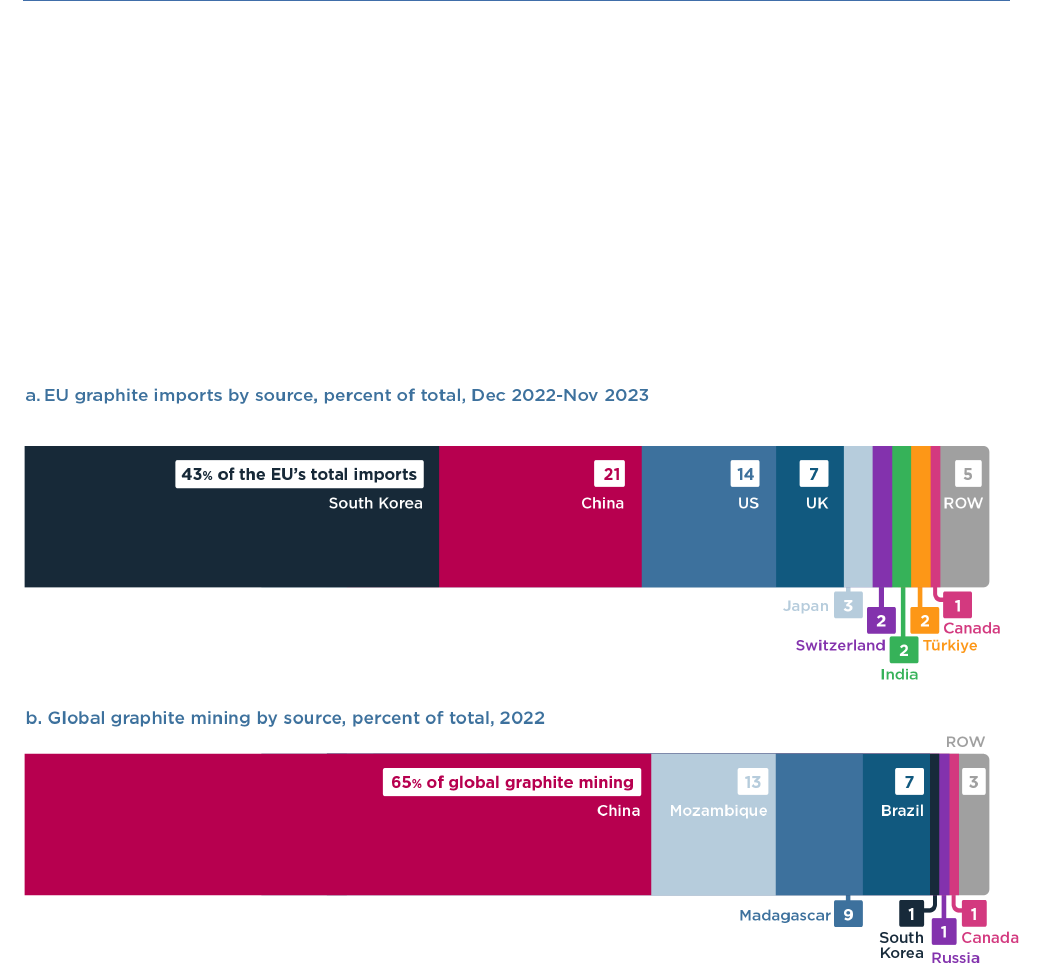
13 WP 24-2 | JANUARY 2024
concerned about excessive dependence on graphite imports from China. Panel
a of figure 4 displays the most disaggregated trade data comparable across
countries (the six-digit Harmonized System level) for the graphite products over
which China ultimately imposed export restrictions. Viewing it alone, they might
have concluded that the European Union had little to worry about, as China is
the source of less than 25 percent of EU graphite imports; South Korea is a larger
foreign source than China, and other trustworthy trading partners, including the
United States, the United Kingdom, and Japan, also export graphite.
Figure 4
The EU’s apparent low import dependence on Chinese graphite may be
misleading given China’s domination of upstream mining
ROW = rest of world
Notes: Total may not sum to 100 due to rounding.
Sources: Panel a: Compiled by the author with data from Eurostat for the 12 months of December 2022–
November 2023, 6-digit HS codes 380110; 38019; 681519; 250410; 380190; 382499. Panel b: Compiled
by the author with 2022 data from USGS, Graphite Statistics and Information, Mineral Commodity
Summaries, 2023.
However, panel b, based on production data, provides cause for concern.
Japan, South Korea, the United Kingdom, and the United States do not mine
(produce) graphite in significant quantities (the European Union also has only
limited graphite mining). In contrast, China produced nearly two-thirds of all
graphite mined globally in 2022. Countries other than China are thus likely
sourcing their raw graphite from foreign sources—likely China. Thus, what
appears to be a diverse set of foreign sources for EU graphite imports (panel a)

14 WP 24-2 | JANUARY 2024
is merely a statistical artifact of the 6-digit Harmonized System code capturing
products beyond those found in the Chinese export restrictions. The implication
is that, if China applied its export restriction on raw graphite universally, then
Japan, South Korea, the United Kingdom, and the United States would be cut
off as well, and the European Union would no longer be able to import graphite
products from them or China.
The European Union’s dependence on China for graphite both illustrates
the problem policymakers seek to address and shows why examining
trade dependencies alone is not enough, as Mejeun and Rousseaux note.
35
Furthermore, graphite is different from other minerals needed for EV batteries
like lithium and cobalt, for which China’s supply chain choke point is not the
mining but the mineral-processing stage.
36
The difference reveals the complexity
of understanding how a country might weaponize a supply chain.
For most other products, the informational challenge facing policymakers
is often worse. Critical minerals are among the few goods for which global
production data are available. Product-level production data are not available for
most manufactured goods of concern for economic security.
3.2 Is China trading more with the European Union because of the US–
China trade war?
Before turning to EU policy instruments, consider a separate question motivated
by the Chinese EV example. Are other economic forces pushing the European
Union to trade more with China—including by importing products like EVs—and
are these forces working against the European desire to de-risk unilaterally?
One such force may arise from the remnants of the (ongoing) US–China trade
war. In July 2018, the United States began to impose additional tariffs on a range
of imported goods from China. China retaliated in kind. By the time the two
countries paused their tariff escalation, in early 2020, new US and Chinese tariffs
covered more than half of their bilateral trade (figure 5). The average US tariff
on imports from China, for example, increased from 3 percent to 19 percent.
37
In part because the European Union and the United States are similar, high-
income consuming economies, if the US tariffs stopped potential Chinese exports
from entering the United States, then Chinese exports may be surging into the
European Union and other third-country markets (trade deflection).
38
Increasing
the chances of this happening is the fact that China also reduced its tariffs
toward the European Union and other third countries throughout the trade war.
39
35 Put differently, graphite would presumably be identified as a strategically dependent product
under a separate criterion examined by Mejean and Rousseaux (forthcoming) that takes into
consideration EU production capacities (which, in the case of graphite, are minimal).
36 Much of the mining of these and other critical minerals outside China is also done by Chinese
firms or joint ventures with Chinese firms, which raises separate issues (Leruth et al. 2022).
37 For an analysis of the US–China trade war, see Bown (2021).
38 For early evidence of trade deflection, see Bown and Crowley (2007). For early evidence from
the US–China trade war, see Fajgelbaum et al. (forthcoming).
39 See Chad P. Bown, Euijin Jung, and Eva Zhang, “Trump Has Gotten China to Lower Its Tariffs.
Just Toward Everyone Else,” PIIE Trade and Investment Policy Watch, June 12, 2019.
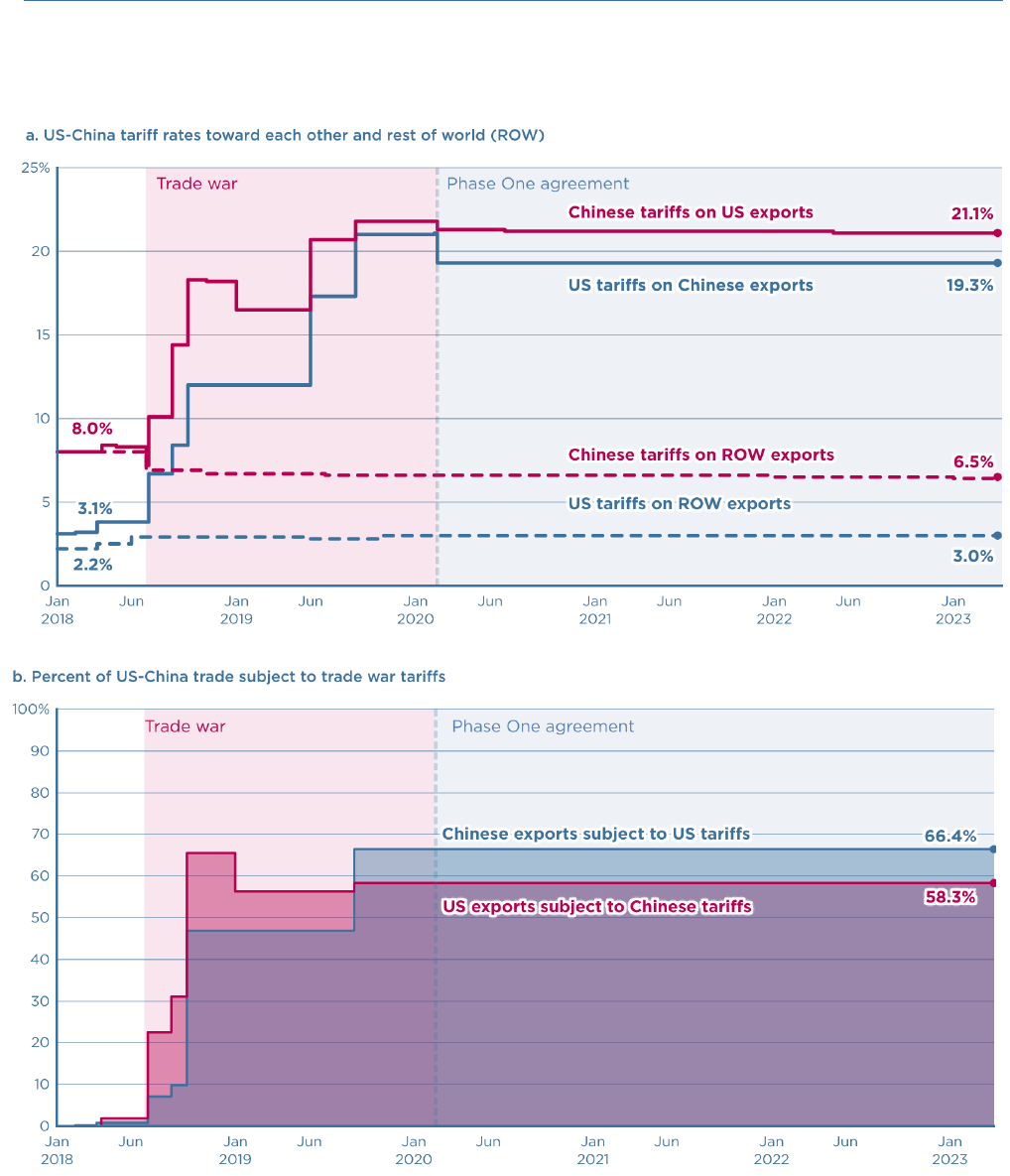
15 WP 24-2 | JANUARY 2024
Figure 5
US and Chinese import tariffs toward each other increased considerably
during the trade war of 2018-19 and have remained elevated since
Source: Bown (2023b).

16 WP 24-2 | JANUARY 2024
As part of the initial wave of tariffs, in July 2018, the United States imposed
25 percent duties on automobiles from China, including EVs, even though China
was not yet exporting EVs in great numbers to anyone (see figure 1). China’s
immediate tariff retaliation included hitting US EV exports and likely accelerated
what was already going to turn into a profound shift in EV trade patterns. China’s
tariffs first contributed to the United States suddenly losing its considerable EV
exports to China, as Tesla accelerated construction of its gigafactory in Shanghai.
The United States then lost its EV exports to the European Union, as Tesla
switched to exporting to the European Union from its new Chinese plant.
40
As of late 2023, China was not exporting many EVs to the United States, in
part because of the additional US trade war tariffs of 25 percent. (US lawmakers
have called for increasing US tariffs on Chinese EVs still further.
41
) In contrast,
China’s exports to the European Union had soared to over $14 billion—more than
3 times the 2021 level and roughly 17 times the levels in 2020 (see again figure 1).
More generally, there is some evidence beyond EVs that China is exporting
more to the European Union because it cannot export to the United States (figure
6). As a starting point, consider China’s exports in June 2018, the month before the
trade war started. By October 2023, China’s total exports to the European Union
had grown by 52 percent, whereas its total exports to the United States had grown
by only 10 percent.
42
These results mask considerable heterogeneity, given that
not all Chinese products were hit with US tariffs. For products not hit with any US
tariffs, Chinese export growth to the United States since June 2018 was higher than
export growth to the European Union (panelb of figure 6).
These results contrast with those for Chinese exports of products subject
to the 25 percent US tariffs. Chinese exports to the European Union of those
products rose 77 percent between June 2018 and October 2023, whereas exports
to the United States declined 5 percent (figure 6, panel c).
43
These tariffs affected
$271 billion of annual Chinese exports to the European Union in the 12 months
ending in October 2023.
The intermediate case involves products subject to US tariffs of only
7.5percent (figure 6, panel d). For these products, the difference between the
growth of Chinese exports to the European Union and its exports to the United
States was only 21 percentage points.
A similar trade-diverting phenomenon has likely arisen in the context of EU
exports to China.
44
As part of the trade war, China retaliated with its own tariffs,
40 See Figures 3 and 4 of Bown (2023a), and the discussion therein.
41 David Shepardson, “US Lawmakers Want Biden to Hike Tariffs On Chinese-Made Vehicles,”
Reuters, November 8, 2023.
42 A separate issue involves the extent to which even the US tariffs are affecting supply chains
beyond the movement of final assembly before shipment to the United States (Chad P. Bown,
“Four Years Into the Trade War, Are the US and China Decoupling?” PIIE Realtime Economics,
October 20, 2022). Freund et al. (2023) suggest perhaps not and provide evidence that foreign
sources replacing China are deeply integrated into China’s supply chains and themselves have
experienced faster import growth from China.
43 These results are not driven exclusively by EVs. Dropping EVs from panel c implies that by
October 2023, there was still a 73 percentage point difference between the growth of Chinese
exports to the EU versus the US for products hit with 25 percent US tariffs since June 2018.
44 Assessing Chinese imports in a way like that shown in figure 6 is complicated by uncertainty
over which products have continued to apply binding tariffs on US exports; it is difficult to
assess, given the purchase commitments in the Phase One agreement of January 2020 (Bown
2021).
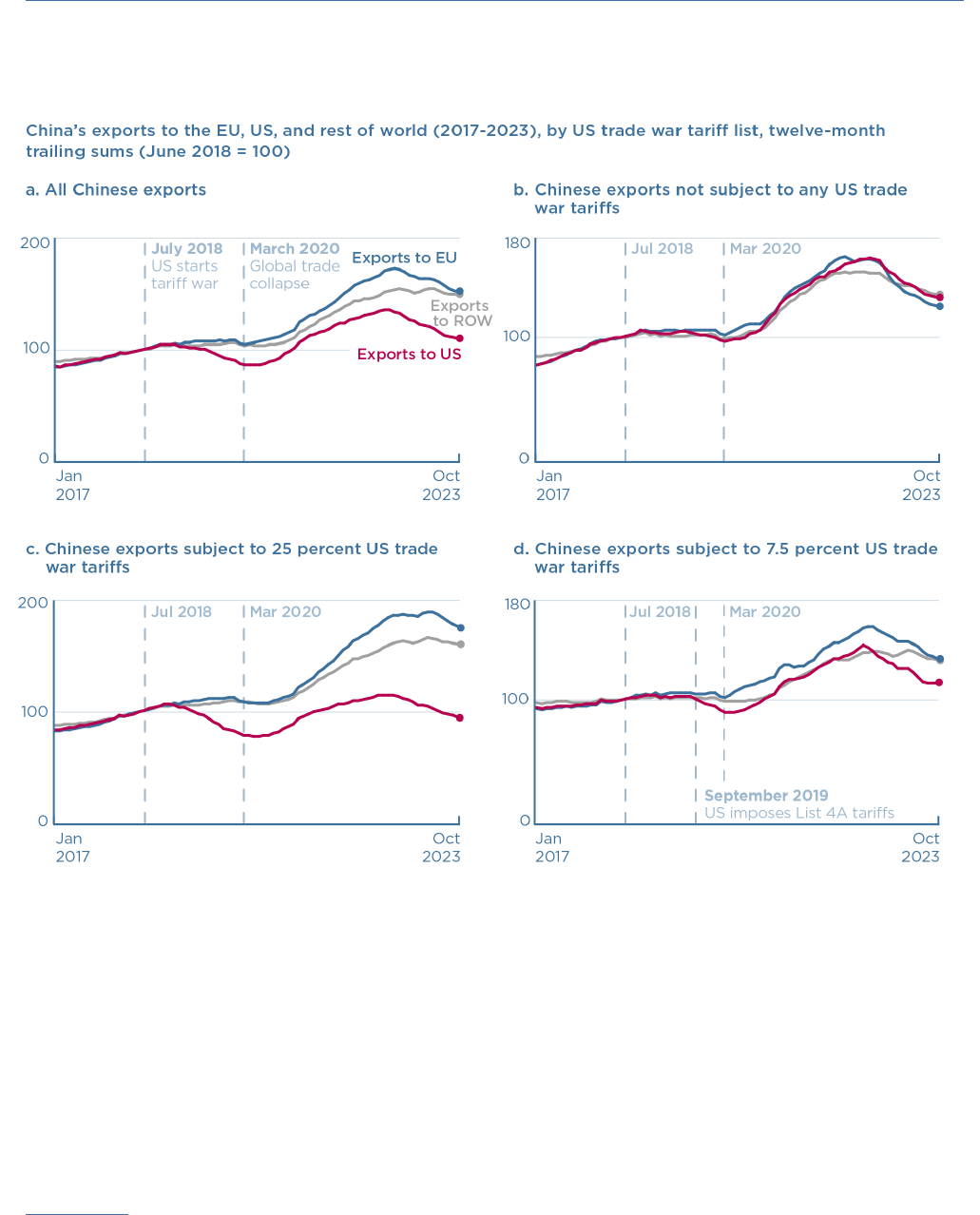
17 WP 24-2 | JANUARY 2024
Figure 6
Is China deflecting exports to the European Union of products hit by US
trade war tariffs?
ROW = rest of world; US = United States; EU = European Union
Source: Constructed by the author with data from UN ITC Trade Map.
which hurt US exports to China. Despite the US–China Phase One agreement of
January 2020—in which China promised to purchase an additional $200 billion of
US goods and services exports over 2020–21—US exports to China have mostly
not resumed.
45
For manufactured goods especially—the most comparable part
of US and EU exports to China—US exports to China remain below pre-trade war
levels (figure 7, panel a). Unsurprisingly, China increased its imports from the
European Union, a pattern that was not reversed when the Phase One agreement
went into effect.
45 See Chad P. Bown, “China Bought None of the Extra $200 Billion of US Exports in Trump’s
Trade Deal,” PIIE Realtime Economics, February 8, 2022; Chad P. Bown and Yilin Wang, “Five
Years into the Trade War, China Continues Its Slow Decoupling from US Exports,” PIIE Realtime
Economics, March 16, 2023.

18 WP 24-2 | JANUARY 2024
Figure 7
China is buying more EU exports and less US exports of manufactured goods
since the trade war
ROW = rest of world; US = United States; EU = European Union
Notes: EU exports converted to US dollars from euros using end of month USD/euro spot exchange rate
from Federal Reserve Economic Data (DEXUSEU).
Source: Constructed by the author with data from US Census (via Dataweb), Eurostat, and UN ITC Trade
Map.

19 WP 24-2 | JANUARY 2024
China cut automobile sector imports from the United States during the trade
war. In contrast, its imports from the European Union remained high, though
they have slowed recently (panel b of figure 7). These factors highlight some of
the German policymaker concerns over German automakers being excessively
dependent on the Chinese market.
46
Overall, these data raise important questions about any EU de-risking
strategy. Economic forces external to the EU–China relationship are pushing the
European Union to trade relatively more with China, not less. If the European
Union seeks to de-risk and European firms do not face all of the societal
incentives to do so, the European Union may need to undertake explicit policy
actions to adjust their incentives.
4. POLICIES TO REDUCE ECONOMIC INSECURITY
The European Union and other governments can deploy multiple policy
instruments to alter firm incentives. This section focuses on five of them:
inventory management, supply-side subsidies, tariffs, export controls, and foreign
investment regulations. It explores examples of how governments are using these
policies for reasons that are consistent with an effort to improve their economic
security. Although the emphasis remains on EU interests, some of the novel
policies worth discussing arise from other countries. This section also reviews
existing WTO system rules (where applicable) as well as potential tweaks to
those rules that might be incorporated to facilitate the use of those instruments
to help achieve domestic policymakers’ objectives.
The working assumption is that policymakers want to balance multiple
objectives. One is to maintain access to critical goods across more states of the
world—even when there is the realization of bad shocks—but recognizing that
bad shocks can also occur at home. However, there is also acknowledgment that
the current geographic concentration of production of certain goods increases
the probability of certain bad shocks; given policymaker uncertainty that firms
are internalizing those risks, government officials may want to create additional
incentives to shift the location of production (or shift it more quickly). Finally,
there is recognition that in the worst states of the world (war, pandemic), a local
supply chain is preferable, because policymakers can compel it to do things they
cannot if production is conducted abroad.
4.1 Inventory management
Holding inventories is one way to help smooth consumption across good and bad
states of the world. Stockpiling can make it more difficult for a malicious foreign
policymaker to impose effective export restrictions. Establishing a credible threat
to release previously produced supplies onto the market to dampen any adverse
price effects could dissuade malevolent policy.
Perhaps the most famous example of stockpiling as such a tool of economic
policy is the Strategic Petroleum Reserve (SPR), an emergency stockpile of
petroleum that the US government established in 1975 after suffering through
46 Germany and the Slovak Republic accounted for 90 percent of EU exports of autos to China in
2023; one of the Slovak Republic’s largest auto production complexes belongs to Volkswagen.

20 WP 24-2 | JANUARY 2024
the economic shocks of shortages and inflation induced by the 1973 OPEC–led oil
embargo. In 2022, following Russia’s invasion of Ukraine, the United States sold
off over 40 percent of the SPR to help limit rising fuel prices globally.
47
In the
European Union, there have been discussions about whether to create a strategic
natural gas reserve. One debate is whether such an arrangement may have eased
the pain or even deterred Russia’s withholding of natural gas exports in 2022 or
in the 2021 lead-up to its February 2022 invasion of Ukraine.
48
Other stockpiling examples are not necessarily motivated by concerns
over cartel-like behavior. In the United States, the Strategic National Stockpile
(SNS) is tasked with maintaining an adequate US inventory of PPE in case of
a public health emergency. The SNS was quickly exhausted early on in the
COVID-19 pandemic, however, leading to PPE shortages with tragic public
health effects (Bown 2022a; Joskow 2022), illustrating how the existence of a
stockpiling program does not imply that it will work in the face of an adverse
shock. (Although it was not weaponized, PPE also did turn out to have had
geographically concentrated production in China.)
Some countries, including India, hold stockpiles of food.
49
With respect to
WTO rules, these stockpiles have become very contentious, as they can conflict
with explicit national commitments to limit subsidies for food products under the
WTO’s Agreement on Agriculture.
50
In the 1970s, stockpiling took on a prominent role in public policy debates out
of fear over cartels for oil and other commodities (Nichols and Zeckhauser 1977).
But inventory management for economic security has its own policy challenges
and tradeoffs. Holding inventories is costly. Governments in power may also
be unable to resist releasing stockpiles for political reasons—to lower prices
to benefit consumers right before an election, for example—making inventory
management for economic security reasons difficult to sustain.
Nevertheless, given that the private sector can hold inventories, it is also
important to understand the nature of any market failures that would create a
role for government. One potential explanation is scale: The size of the optimal
stockpile may be sufficiently large that no private sector actors may emerge. A
second is the potential time-inconsistency problem. Although policymakers may
encourage stockpiling, the private sector may fear that the emergence of a crisis
that causes them to draw down (and profit from) their inventories will make
policymakers reverse course by imposing price controls or taxing “excess profits,”
thereby eliminating the value of the private sector’s investments. (The inability of
policymakers to tie their own hands discourages the private sector from creating
stockpiles in the first place.)
47 Ben Lefebvre, “Biden Sold Off Nearly Half the US Oil Reserve. Is It Ready for a Crisis?” Politico,
October 16, 2023.
48 S&P Global, “Time for Europe and the IEA to Create a Strategic Gas Reserve,” Commodity
Insights, September 27, 2021. Beginning in mid-2021, months before invading Ukraine, Russia
limited natural gas exports to Europe to long-term contracts and ended spot market sales (US
Energy information Administration, “Russia’s Natural Gas Pipeline Exports to Europe Decline to
Almost 40-Year Lows,” August 9, 2022).
49 See Pratik Parija, Anup Roy, and Bibhudatta Pradhan, “India’s Grain Stockpiles Key to Modi’s
Pre-Election Strategy,” Bloomberg, August 8, 2023.
50 For a discussion, see Glauber and Sinha (2021).

21 WP 24-2 | JANUARY 2024
Finally, inventories are feasible only for certain types of goods. Stockpiling
cannot work for goods that need to be invented to address an emergency, such
as new diagnostics, treatments, or vaccines in response to a pandemic. Holding
inventories will also be less effective at addressing shortages of goods with quick
product cycles—such as advanced node semiconductors—whose value starts
high but then may diminish quickly as they are replaced by newer products.
4.2 Production subsidies and the management of capacity utilization
One way to incentivize the movement of a supply chain away from its current
location is through a subsidy. In theory, there are at least two ways to condition
the subsidy. One is to grant it provided the supplier leaves its current location.
Another is to allocate it if the firm arrives (and starts investing or producing) in a
particular location. This distinction has become important, as explored below.
51
One potential benefit to a subsidy may be increased diversification and thus
continued provision of output in certain states of the world, such as when a
foreign shock might otherwise have cut off supplies. There may also be spillovers
if the subsidy moves production to a local supplier, giving local policymakers
greater control (or responsiveness) in case of an emergency. In the case of
COVID-19 vaccine production, for example, US government use of the Defense
Production Act and priority-rated contracting was likely effective at triggering an
earlier and larger production response than it would have had the United States
not had local manufacturing capacity.
52
Subsidies are also costly, however, for several reasons. First, subsidies
involve fiscal costs. Second, efficiency costs may emerge if forced diversification
results in firms producing at a smaller scale or otherwise losing access to local
agglomeration externalities. Ongoing subsidization may be required if the
objective is to maintain domestic production in the new environment even if the
new industry is not competitive with foreign firms. (An alternative would be less
efficient protection via tariffs.)
Even subsidies to maintain some domestic production do not guarantee
greater responsiveness to an emergency, however. For example, the US
government funded a program to keep production capacity for vaccines
set aside (in reserve) in case of a pandemic. But the contractor, Emergent
BioSolutions, mismanaged the manufacturing process of the Johnson & Johnson
and AstraZeneca vaccines when COVID-19 hit, forcing it to destroy hundreds of
millions of doses of the vaccines (Bown and Bollyky 2022). (This transgression
has been largely forgiven by history, because of the success of mRNA vaccines
by Pfizer/BioNTech and Moderna, which made those tainted vaccines superfluous
for the US market.)
Existing WTO rules have two main concerns with subsidies.
53
The first is that
the WTO prohibits subsidies contingent on local content (as opposed to the use
of imported inputs) or exports. The second involves the potential international
51 For a new database on contemporary use of industrial policy, see Evenett et al. (2024).
52 For a discussion of DPA and priority-rated contracting as it was applied to COVID-19 vaccine
supply chains, see Bown (2022a). For recent EU proposals, see Aurélie Pugnet, “European
Commission Mulls New European Defence Act before End of Year,” Euractiv, September 4,
2023.
53 For a discussion, see Bown (forthcoming).

22 WP 24-2 | JANUARY 2024
economic externalities of the subsidy and whether it erodes the partner’s
expected access to the EU or third-country markets. Such harmful effects—which
are likely to emerge for large producing economies like the European Union—
make these subsidies “actionable” and subject to a policy response by the
adversely affected trading partner. The cost–benefit calculation influencing the
European Union’s decision on whether to impose a subsidy may thus also need to
consider additional costs, such as the lost export market access for a different EU
industry if its subsidy induces (WTO–consistent) retaliation by the trading partner.
The next sections highlight examples of governments using subsidy policies
in an attempt to de-risk. It also describes some government efforts to subsidize a
supply chain to leave one country and go into a third country.
4.2.1 The Inflation Reduction Act and US subsidies for critical minerals
Under the Inflation Reduction Act (IRA) of 2022, the United States has developed
a creative approach for subsidizing the creation of supply chains outside of
China. In trade circles, the IRA is best known for the local content requirement
of its EV consumer tax credits under Section 30D, which led to trade disputes
with Europe and South Korea that the Biden administration resolved through a
regulatory decision in which subsidies for leased EVs were exempt from the local
content requirement (Bown 2023a, 2024).
For critical minerals and materials, however, more important are Section
30D’s provisions requiring that, over time, even vehicles assembled in North
America cannot receive the consumer tax credit if these key battery inputs
continue to be sourced from China. The law also implicitly recognizes that many
critical minerals are unlikely to be mined or processed in the United States.
It therefore allows for tax credit eligibility if the critical minerals are sourced
from a US free trade agreement (FTA) partner. In a March 2023 decision, the
US Treasury expanded the definition of free trade agreement partner to extend
beyond the 20 countries with which the United States has a Congressionally
approved FTA to include other countries with which the US government might
negotiate critical minerals agreements.
To date, the United States has negotiated such a critical minerals agreement
with only one country (Japan) to completion; it is in talks with the European
Union and the United Kingdom. There have also been public reports of requests
from other countries, such as Indonesia and the Philippines. South Korean battery
companies (which have significant manufacturing plants in the United States)
have lobbied the United States to negotiate such agreements with Indonesia
and Argentina, presumably because they source critical minerals from those
countries.
54
The United States has been unresponsive to date, in part because
much of the nickel industry in Indonesia involves Chinese ownership or joint
ventures of local firms with Chinese firms.
55
These arrangements may therefore
not address the concerns over supply chain control driving US worries over its
economic security.
54 Kyongae Choi, “Finance Minister Calls for US Cooperation in IRA Guidance on Critical Minerals,”
Yonhap News Agency, February 26, 2023.
55 Mercedes Ruehl, Christian Davies, and Harry Dempsey, “Indonesia Business Presses US over
Green Subsidies for EV Minerals,” Financial Times, March 29, 2023.

23 WP 24-2 | JANUARY 2024
As neither the European Union nor the United States is likely to mine or
process significant amounts of critical minerals domestically, a bilateral critical
minerals agreement may not be particularly valuable to either. Nevertheless,
European automakers and battery manufacturers would likely benefit from
creation of a separate critical minerals supply chain outside of China that could
result from US policy incentives. Even if European automakers continue to source
from China, the existence of alternative suppliers would reduce China’s supply-
side market power, to the benefit of all potential buyers.
Of course, creating additional supply chains to limit China’s ability to
weaponize its exports is a costly approach to tackling the climate crisis. It would
be more efficient globally to negotiate new rules with China to discipline its use
of export restrictions as part of a bigger package of cooperation on trade and
climate (Bown and Clausing forthcoming).
4.2.2 Japan’s “China exit” subsidies
Japan’s recent efforts illustrate a second example of creative subsidies to de-
risk from China. In the face of early COVID-19 supply chain disruptions facing
Japanese firms in China, the Japanese government earmarked $2.2 billion in
April 2020 to “China exit” subsidies—subsidies for the affiliates of Japanese-
headquartered firms to leave China. Nearly 10 percent of the funding—and 30
of the 87 projects announced in July 2020—involved the Japanese government
subsidizing firms to move production from China to third countries in Southeast
Asia, such as Laos, Vietnam, and Malaysia,
56
in part to take advantage of
comparative advantage and the existence of local, pre-existing supply chains.
Although some production lines involved PPE and other COVID-19-related
products—and thus were in response to immediate concerns of supply shortages
coming out of China—subsidies were also granted to Japanese firms making
products completely unrelated to the pandemic, including aviation parts, auto
parts, and fertilizer.
4.2.3 Subsidies and coordination of the movement of semiconductor supply
chains
There are multiple issues of concern about the future location of production
of semiconductors. One is the subsidies China has provided to the industry
(OECD 2019) and its stated goal (in the Made in China 2025 industrial policy) to
dominate the sector globally, which could result in it having supply-side market
power that it could weaponize. Another potential concern involves the existing
geographic concentration of semiconductor production in East Asian hotspots
(Taiwan, South Korea), especially the most advanced nodes in Taiwan, by TSMC.
The semiconductor shortages that arose in 2021 hurt Europe. German
automakers in particular were forced to cut back production, with considerable
impact on the German economy.
57
56 See Isabel Reynolds and Emi Urabe, “Japan to Fund Firms to Shift Production out of China,”
Bloomberg, April 8, 2020; Nikkei Asia, “Japan Reveals 87 Projects Eligible for ‘China Exit’
Subsidies,” July 17, 2020.
57 Joe Miller and Martin Arnold, “Car Chip Shortage Weighs on German Economy,” Financial
Times, July 7, 2021.

24 WP 24-2 | JANUARY 2024
Two main factors drove the auto industry shortage. The first was global
automakers’ decision to pull semiconductor orders in response to the mobility
restrictions imposed in early 2020 because of the pandemic. The second was
that, seeing heightened demand because of those restrictions, semiconductor
manufacturers quickly replaced those orders with higher-value chips from
consumer electronics firms.
58
As a result, when mobility restrictions were
lifted and automakers tried to place new orders later in the year, there was a
major backlog, as semiconductor manufacturers were operating at capacity
and producing more profitable varieties of chips. The experience heightened
European policymaker awareness that Europe had a dwindling share of global
chip manufacturing and thus little control over the supply chain in the event of
an emergency.
59
Since then, policymakers have sought both to diversify more
production out of East Asia and to bring some of it to Europe, in part to retain
some control over suppliers in the event of future shocks.
Germany has reportedly offered as much as €5 billion of subsidies for TSMC
to construct a manufacturing facility in Dresden. The complex arrangement
involves equity stakes by NXP, Infineon, and Bosch and thus required sign-off
over any anti-trust concerns by the German cartel office.
60
Other countries are also working to diversify TSMC’s production outside
of Taiwan. Japan granted over $3 billion in subsidies to the company to build
a facility on the island of Kyushu.
61
The United States is expected to subsidize
TSMC’s construction of a plant in Arizona once it begins to disburse funding
made eligible under the CHIPS and Science Act of 2022.
62
Germany has also promised Intel nearly €10 billion of subsidies for two plants
in Magdeburg.
63
Intel has also received subsidies for a new assembly, packaging,
and test facility in Poland, which is likely to service the German plants.
64
France
will provide €2.9 billion of subsidies to GlobalFoundries for a new facility with
STMicroelectronics in southeastern France.
65
58 See Semiconductor Industry Association, “Semiconductor Shortage Highlights Need to
Strengthen U. Chip Manufacturing, Research,” Blog, February 4, 2021.
59 In May 2021, the US government reportedly contemplated using the Defense Production Act
to forcibly allocate some production of chips toward similarly harmed auto plants in the United
States. It decided against it, because doing so would have simply reallocated semiconductors
away from goods like consumer electronics that were still in high demand because of
pandemic-era mobility restrictions requiring work from home and school from home. (See
Trevor Hunnicutt, Andrea Shalal, and David Shepardson, “Exclusive: Facing Chips Shortage,
Biden May Shelve Blunt Tool Used in COVID Fight, Reuters, May 5, 2021.)
60 See Debby Wu and Aggi Cantrill, “TSMC to Build $11 Billion German Plant with Other
Chipmakers,” Bloomberg, August 8, 2023; Linda Pasquini, “Germany Approves Stakes by
Bosch, Infineon and NXP in TSMC Chip Plant,” Reuters, November 7, 2023.
61 Kana Inagaki, “How TSMC’s Chip Plant Is Shaking Up Japan,” Financial Times, September 25,
2023.
62 Cecilia Kang, “How Arizona Is Positioning Itself for $52 Billion to the Chips Industry,” New York
Times, February 22, 2023.
63 Friederike Heine, Supantha Mukherjee, and Andreas Rinke, “Intel Spends $33 Billion In Germany
In Landmark Expansion,” Reuters, June 19, 2023.
64 Karol Badohal and Supantha Mukherjee, “Focus: How Poland Snagged Intel’s Multi-Billion
Dollar Investment,” Reuters, June 22, 2023; Intel, “Intel Plans Assembly and Test Facility in
Poland,” Press release, June 16, 2023.
65 Dominique Vidalon and Sudip Kar-Gupta, “France to Provide 2.9 Billion Euros in Aid for New
STMicro/ Globalfoundries Factory,” Reuters, June 5, 2023.

25 WP 24-2 | JANUARY 2024
It is noteworthy that Europe and other key US allies have provided government
support to US–headquartered companies like Intel, GlobalFoundries, Micron, and
IBM, given that most of these companies are expected to apply for and receive
CHIPS Act funding that also expands US–based production. (Micron will also
receive $1.3 billion from the Japanese government for a factory in Hiroshima,
66
and IBM has partnered with Rapidus, a newly formed Japanese semiconductor
manufacturer, to produce advanced-node chips in Japan.
67
) Although the CHIPS
Act included guardrails to prevent companies that accept US funding from
expanding their manufacturing facilities in China, the US administration has not
complained about allied countries subsidizing US–headquartered firms.
Under the CHIPS Act, the United States also has created incentives similar
to Japan’s China exit/third-country subsidies. Up to $500 million may be used
to subsidize assembly, packaging and test facilities in labor-abundant countries
outside the United States. In 2023, for example, the United States announced
that it was exploring such partnerships with Panama, Costa Rica, and Vietnam.
68
(Intel, for example, already has facilities in Costa Rica and Vietnam.)
Many, including prominent European policymakers,
69
have described the
proliferation of state funding for semiconductors as simply a “subsidy war.” While
this is a risk, a more nuanced view is that Europe and the United States have
common objectives and would benefit from coordinating their uses of industrial
policy. Even before the inauguration of the Biden administration, in January 2021,
the European Commission released a blueprint seeking to reboot transatlantic
ties after the Trump administration.
70
The Biden administration has made similar
efforts; the United States and the European Union established the Trade and
Technology Council early in 2021, using it, in part, to discuss coordination of their
industrial policies for semiconductors. This information-sharing has also extended
to Japan, a country with common concerns.
71
Nevertheless, not all subsidies that these governments are disbursing are in
this vein. In Japan, for example, 90 percent of the 2020 China exit subsidies were
66 Yoshiaki Nohara, “In Boost for Chip Ambitions, Japan Inks $1.3 Billion in Subsidies for Micron
Plant,” Bloomberg, October 2, 2023.
67 Tim Kelly and Jane Lee, “IBM Partners with Japan’s Rapidus in Bid to Manufacture Advanced
Chips,” Reuters, December 12, 2022.
68 See US State Department, “Department of State Announces Plans to Implement the CHIPS
Act International Technology Security and Innovation Fund,” Press release, March 14, 2023;
US Department of State, “New Partnership with Costa Rica to Explore Semiconductor Supply
Chain Opportunities,” Press Release, July 14, 2023; US Department of State, “New Partnership
with Panama to Explore Semiconductor Supply Chain Opportunities,” Press Release, July 20,
2023; US Department of State, “New Partnership with Vietnam to Explore Semiconductor
Supply Chain Opportunities,” Press release, September 11, 2023; Francesco Guarascio, “Vietnam
Eyes First Semiconductor Plant, US Officials Warn of High Costs,” Reuters, October 30, 2023;
Reuters, “Intel to Invest $1.2 Bln In Costa Rica over Next Two Years,” August 30.
69 “‘It’s like a declaration of war,’ Robert Habeck, Germany’s vice-chancellor and economics
minister, said last month. . . . ‘The [Americans] want to have the semiconductors, they want
the solar industry, they want the hydrogen industry, they want the electrolysers,’ Harbeck told
a business conference.” See Guy Chazan, Sam Fleming, and Kana Inagaki, “A Global Subsidy
War? Keeping Up with the Americans,” Financial Times, July 13, 2023.
70 European Commission, “A New EU–US Agenda for Global Change,” Joint Communication to
the European Parliament, European Council and the Council, December 2, 2020.
71 See Yuka Hayashi, “US, EU Agree to Coordinate Semiconductor Subsidy Programs,” Wall
Street Journal, December 5, 2022. Rihao Nagao, “Japan and EU to Share Chip Subsidy Info to
Disperse Production. Three-Way Exchange with US Aims for Better Supply Chain Distribution,”
Nikkei Asia, June 29, 2023.

26 WP 24-2 | JANUARY 2024
earmarked for production to leave China by returning to Japan. For PPE, the US
government spent over $1 billion in 2020–21 to subsidize the creation of entire
domestic supply chains in response to the shortages arising during the early days
of COVID-19 (Bown 2022a). In the IRA, a plethora of local content provisions
attempts to incentivize clean energy projects to disproportionately rely on US–
made inputs like steel.
4.3 Tariffs
Tariffs are another instrument potentially affecting supply chains. They can be
used to address two different margins.
First, a government can raise its tariffs on all trading partners—by, for
example, raising its most favored nation (MFN) tariff. Doing so creates incentives
for increased local production because it discriminates equally against all
foreign firms. An MFN tariff creates incentives similar to the production subsidy
described in section 4.2, but it does so less efficiently, as it also increases the
price to domestic consumers. (The effect of a 10 percent tariff is equivalent to
the combined effect of two domestic policy instruments, a 10 percent production
subsidy and a 10 percent consumption tax).
The potential WTO concern with simply raising the MFN tariff is that tariffs
are legal commitments under Article II of the General Agreement on Tariffs
and Trade (GATT). However, specific rules are written into the WTO allowing
governments to increase those binding tariff commitments. Under GATT Article
XXVIII, a WTO member can raise its MFN tariff without even having to resort to
arguments that its domestic industry is injured or that it faces an import surge
or that imports are unfair because they are being subsidized or dumped into the
market. The cost of using Article XXVIII is that trading partners are permitted to
retaliate by reciprocally raising their tariffs.
Second, a government can change the tariffs it imposes on some countries
but not others, in order to encourage imports from country B in lieu of country
A, by either lowering the tariff facing exporters in B selectively or raising the
tariff facing exporters in A selectively. The relative efficacy of the two options
also depends on the starting point. In the extreme example in which the
country’s starting point MFN tariff is zero, the only policy option is the second, as
governments rarely subsidize imports.
The WTO concern with discriminating between two foreign sources of
imports is violation of the MFN principle in GATT Article I. Even this constraint
is not legally insurmountable, however, as the WTO provides for numerous
exceptions to MFN. The biggest loophole is GATT Article XXIV, which allows
countries to lower tariffs toward one another preferentially under an FTA,
provided doing so covers substantially all trade. (Multiple such agreements are
already in place with the European Union, including with major economies such
as Japan, Korea, Canada, and most recently the United Kingdom. It also has
a customs union with Turkey.
72
) Otherwise, applying tariffs in a discriminatory
72 The European Union has negotiated such agreements with other economies, including Mexico
and MERCOSUR (awaiting ratification); it is conducting negotiations with others, including
India and Indonesia. See European Commission, “Negotiations and Agreements,” last accessed
December 31, 2023.

27 WP 24-2 | JANUARY 2024
manner across WTO members requires resort to specific TDIs. For example, if
imports from country A have been dumped (antidumping duty) or subsidized
(countervailing duty), causing injury to the domestic industry, the WTO member
can impose a TDI on imports from country A (but not B), thereby creating the
differential tariff treatment that generates incentives to source from country B
instead of country A.
If the European Union is committed to following WTO rules, it could legally
adopt explicit approaches to shift its relative tariffs to create private sector
incentives to encourage more diversification beyond that already implied by
its existing web of FTAs and customs unions. Each of the three approaches
described next has tradeoffs.
4.3.1 The proactive approach to tariffs
A first, proactive approach to de-risking would involve two steps. The first would
be for the European Union to increase its MFN tariffs under GATT Article XXVIII,
as described above. The cost would be that trading partners would be allowed to
retaliate by reciprocally raising their tariffs. Which trading partners would do so
is an important issue, examined below.
The second step would be for the European Union to negotiate additional
FTAs with preferred trading partners under GATT Article XXIV. Unlike an action
under Article XXVIII, these preferred trading partners have to be willing to find
such an agreement mutually advantageous. But as long as the agreement covers
“substantially all trade,” it would be WTO consistent.
Going back to the first step, trading partners receiving better-than-MFN tariff
treatment from the European Union would not seek retaliation (or rebalancing).
The only countries likely to retaliate would be those that the European Union is
seeking to de-risk from in the first place.
The effect of this policy would be similar to where the United States and
China ended up with each other as a result of their trade war (see figure 5),
with each country applying higher tariffs toward the other than it does toward
other WTO members. The difference is that in the US–China case, the MFN
tariffs are the low tariffs and the discriminatory tariffs are the high tariffs. In the
hypothetical case proposed here for the European Union, the MFN tariffs would
be the high tariffs and the discriminatory tariffs the low tariffs.
4.3.2 The reactive approach to tariffs
The second approach—establishing contingent tariff instruments to deploy if
certain conditions arise—is the current EU approach. One such policy is the
European Union’s new anti-coercion instrument (ACI), which could be used
to retaliate if (say) China repeated something similar to what it recently did
to Lithuania.
73
Other policies include TDIs. The European Union could, for example, impose
countervailing duties after an investigation into whether imported goods that
73 European Parliament, “Anti-Coercion Instrument: The EU’s New Weapon to Protect Trade,”
Press release, October 3, 2023. An important initial motivation for the ACI was the Trump
administration’s tariffs, threats, and other actions beginning in 2018 (Hackenbroich and Zerka
2021; Wu 2023).

28 WP 24-2 | JANUARY 2024
caused injury to European producers were subsidized (see the EV example
described in section 3.1). At the time of writing, the European Commission was
reportedly considering self-initiating similar anti-subsidy investigations into
Chinese wind turbines and steel.
74
Alternatively, the European Union could
impose a substitutable TDI, such as antidumping. Such TDIs are not new to the
European Union; through 2019, over 6 percent of EU imports from China were
already subject to a TDI (Bown 2022c).
One limitation of these instruments is that they are reactive. If they need to
be triggered, their deterrence value has failed. In addition, showing evidence of
injury to the domestic industry (let alone subsidized or dumped imports) often
implies that the foreign industry has already been established (and is a successful
exporter) and the TDI is going to have limited effectiveness at addressing the
larger concerns of trading partner subsidies distorting global economic activity.
Another limitation is that existing TDIs are not directly linked to concerns
over economic security or that the European Union is becoming overly
dependent on a particular foreign supplier. Put differently, the European Union
could become overly reliant on one country as an import source, but without that
country having subsidized production or dumped its exports into the EU market,
that country would not meet the legal criterion to trigger traditional TDIs.
One historical argument in favor of TDIs may also now need to be
abandoned. Under the rules-based trading system, many observers viewed a
country’s use of TDIs as a signal of adherence to WTO rules (as countries could
have imposed protection in some other, less transparent form but did not). Under
WTO rules, policymakers are supposed to be able to impose TDIs “for free.” Yet
numerous examples of China retaliating against EU TDIs illustrate the limited
value of seeking to avoid trading partner retaliation by shifting import protection
into TDIs instead of another instrument.
75
4.3.3 A middle-ground approach to tariffs
If renegotiating a country’s relative tariff profiles is politically infeasible and the
existing TDIs imperfectly address concerns over economic security, policymakers
could consider a new TDI proposal. Suppose governments could trigger a
bilateral trade restriction for goods with geographically concentrated production
when bilateral dependence exceeds a certain critical threshold. For example,
when Russian gas or Chinese graphite hits (say) 30–40 percent of EU market
penetration, the European Union could be permitted to impose an import quota
to prevent the volume from increasing further.
There is value to a well-designed new TDI if it helps prevent excessive
dependencies, weakens a trading partner’s ability to weaponize its exports,
and thus helps keep markets open in a world threatened by policy responses to
economic security. Furthermore, such a remedy might not be much worse than
the existing TDIs (antidumping, countervailing duties, safeguards), given that
74 See Andy Bounds, “EU Plans Anti-Subsidy Probe into Chinese steelmakers,” Financial Times,
October 10, 2023; Alice Hancock and Andy Bounds, “EU Considers Anti-Subsidy Probe Into
Chinese Wind Turbines,” Financial Times, October 6, 2023.
75 China’s retaliation to EU TDIs is reminiscent to how China retaliated beginning in 2009 to US
use of TDIs (see Bown 2019).

29 WP 24-2 | JANUARY 2024
they also target something other than short-run economic efficiency. Economists
have suggested that the costs to such TDIs could be offset if they serve other
beneficial functions, including acting as an escape value (increasing trade
barriers only selectively) and allowing governments to maintain greater trade
policy cooperation overall in the face of shocks.
76
Bagwell and Staiger (1990),
for example, develop a theory from a repeated game setting in which terms-
of-trade shocks generate pressure to increase tariffs. They show how TDIs can
help governments avoid defection. Bown and Crowley (2013) provide evidence
consistent with this motive affecting US use of TDIs in 1997–2006.
The downside of using such TDIs includes the static inefficiency costs
associated with any additional act of import protection (unless the policy-
imposing country is large and can extract terms-of-trade gains, as through an
optimal tariff). Making a new TDI available could also promote rent-seeking and
firms wasting valuable resources in an effort to obtain protection. A cooperative
and enforceable agreement in which all countries committed not to impose
export restrictions or tariffs would yield better joint outcomes. (The assumption
is that fully cooperative policy is currently impossible.)
In addition to short-term inefficiencies, any application of this new TDI
policy would also be costly for buying firms. A government policy that forced
some firms to source from a higher-cost third-country supplier would hurt their
competitiveness. There may thus be a complementary role for subsidizing such
firms to offset those losses.
Two other concerns with such a proposal are the difficulty of setting criteria
for such a new TDI and the nonavailability of sufficiently precise supply chain
data to administer it effectively. For example, what is the right threshold level
past which the TDI would be triggered? Even the 30 percent import dependency
threshold would not have identified graphite from China as a product from
which the European Union should seek to diversify import sources based on
the six-digit import data (see figure 4). Furthermore, the source country’s
share of global production is also critical but often much more difficult for a
policymaker to obtain.
4.4 Export controls
The change in geopolitics has increased the use of export controls, including by
the European Union and its member states. Historically, such export restrictions
have often been imposed on dual-use goods for national security reasons.
77
Some of the modern applications have come alongside the United States’ use of
export restrictions targeting China. Others were imposed in response to Russia’s
invasion of Ukraine.
To see why export controls have increased, assume there is a negative
externality associated with the European Union exporting some good or service
to another country. One example is the equipment created by ASML in the
76 For an economic model whereby such TDIs can act as insurance for import-competing sectors
affected by negative price shocks, see Fischer and Prusa (2003).
77 A dual-use good is one, such as high-end chips, that can be used for both innocuous purposes
(video games, smartphones, or socially beneficial artificial intelligence applications) and
advanced weapons systems or other military purposes that might endanger national security.

30 WP 24-2 | JANUARY 2024
Netherlands to manufacture advanced-node semiconductors, a dual-use good.
When that negative externality arises because of the export of the good, a first-
best policy can be an export ban.
Export controls are mostly undisciplined under WTO rules. Article XI of the
GATT provides the basic guidelines for export restrictions. Export quotas are
forbidden, but the potentially economically equivalent policy instrument of
an export tax is not. Even the ban on export quotas is subject to exceptions,
as the prohibition does not extend to instances in which it is “temporarily
applied to prevent or relieve critical shortages of foodstuffs or other products
essential to the exporting contracting party,” where neither temporarily nor
essential is defined.
4.5 Regulation of foreign investment
Governments are also worried about foreign policymakers acquiring access to
goods or services that threaten their national security or otherwise taking actions
that reduce their economic security, through state-directed foreign investment
decisions. One way this could happen is through inbound investment (foreign
firms acquiring local firms for their sensitive technologies).
Since 1975, the Committee on Foreign Investment in the United States (CFIUS)
has reviewed, mitigated, and even blocked such transactions from taking place
in the United States.
78
In 2020, the European Union’s Foreign Direct Investment
Regulation took effect. It encourages member states to create inbound foreign
direct investment (FDI) screening systems, set minimum standards for such
systems, and establish a mechanism for coordinating such reviews across
members. By 2022, two-thirds of EU member states had inbound FDI screening
legislation in place (European Commission 2023b). In 2023, however, Germany’s
foreign investment screening process was caught up in controversy when the
German government allowed COSCO, the Chinese state-owned shipping company,
to take a sizable ownership stake in a Hamburg port terminal.
79
An additional regulatory policy tool affecting European inbound FDI is the
European Union’s new Foreign Subsidies Regulation.
80
It was established out of
concern that foreign-headquartered firms could imperil the level playing field of
the EU’s internal market by providing subsidies to their affiliates operating in EU
member states. Even if the European Union wants the main benefit of the policy
tool to be to deter foreign subsidization, the FSR seems likely to be triggered,
especially given the increasing levels of Chinese investments into the EU market
(see the concerns raised by the EV battery example described in section 3.1).
An additional potential tool is the regulation of outbound FDI out of concerns
over policy substitution. For example, the Netherlands, the United States, and
Japan have coordinated their export controls to prevent physical goods—such
as equipment to manufacture high-end semiconductors that might prove
78 See Congressional Research Service (2018) for the history of CFIUS and an overview of how it
has been used.
79 Hans von der Burchard, “Germany Doubles Down on China Port Deal Despite New Security
Concerns,” Politico, May 10, 2023. For data on how Germany has used foreign investment
screening, see Federal Ministry for Economic Affairs and Climate Action of Germany,
“Investment Screening in Germany: Facts & Figures,” January 9, 2023.
80 For a discussion of the regulation, see Andhov, Biondi, and Rubini (2023, 80–85).

31 WP 24-2 | JANUARY 2024
beneficial for advanced weapons systems—from getting to China. However,
the US government is also worried that American investors may provide China
with the financial resources to develop the product or industry. One way it has
attempted to limit this possibility is through the constraints in the CHIPS Act
funding—that companies applying for and accepting US federal subsidies for
their investments in the United States face limits on investments in their Chinese
operations for 10years.
81
In addition, in an August 2023 Executive Order, the
Biden administration announced a limited screening process to deter American
investments in China and other countries that could help them develop military
technologies.
82
The European Commission is similarly examining security risks
associated with outbound investments (European Commission 2023a).
5. NEW FORMS OF (SELECTIVE) INTERNATIONAL COOPERATION
Geopolitics and the fear that certain foreign policymakers are actively working
against the European Union’s economic security goals leave little immediate-
term hope for additional multilateral cooperation on trade.
83
However, there is
still considerable scope for selective cooperation, especially among countries
that have common de-risking objectives and similar concerns over malicious
policymakers abroad. In fact, the failure to coordinate such policies may often
undermine each individual countries’ economic security objectives. This section
introduces a number of new scenarios likely to arise, and the tradeoffs associated
with different approaches to selective international cooperation to tackle them.
5.1 Joint application of export controls toward third parties
First consider the issue of export controls. Export controls are difficult for
policymakers to impose even on their own firms because they eliminate market
access opportunities. Furthermore, unilateral export controls may result mainly in
self-harm if there are other innovative countries capable of producing the goods
being controlled. Not only are such unilateral controls unlikely to prevent the dual
use goods from getting to the adversary, but the unilateral restriction will end up
hurting only the competitiveness of the national industry.
The Trump and Biden administrations used slightly different approaches
to ensure that US–led export controls ended up being so comprehensive. The
Trump administration mainly coerced firms in trading partners through an extra-
territorial application of what is referred to as the foreign direct product rule
(FDPR). It states that if a foreign firm does not voluntarily follow US export
controls, it can lose access to the US inputs and technology it needs (at least in
81 Commerce Department, “Preventing the Improper Use of CHIPS Act Funding. A Rule by the
National Institute of Standards and Technology,” 88 Federal Register 65600, September 25,
2023.
82 See White House, “Executive Order on Addressing United States Investments in Certain
National Security Technologies and Products in Countries of Concern,” August 9, 2023;
Department of Treasury, “Provisions Pertaining to US Investments in Certain National Security
Technologies and Products in Countries of Concern,” A Proposed Rule by the Investment
Security Office, Federal Register, August 14, 2023; Martin Chorzempa, “Biden’s New Outbound
Investment Restrictions with China Are A Sensible Compromise, But Further Tightening Is
Likely,” PIIE Realtime Economics Watch, August 10, 2023.
83 A counterargument is the existential and global threat of climate change, for which the only
solution is multilateral cooperation. See Bown and Clausing (forthcoming).

32 WP 24-2 | JANUARY 2024
the short run) to produce the good being controlled. The Biden administration
has mostly taken a different approach. Alongside its export controls on
equipment to manufacture advanced node semiconductors, for example, it
has exerted considerable diplomatic effort to convince key governments in
the Netherlands and Japan of the underlying national security concern and to
voluntarily impose similar controls on their firms rather than using the FDPR.
Coordinating export controls across all major producers is essential if the
policy is to work. Uncontrolled foreign firms have an incentive to backfill and
provide the technology, goods, or inputs needed. Coordinating export controls
across countries is also extraordinarily difficult, however, especially without an
institutional arrangement and ex ante agreement on when and how to do so.
Without access to the intelligence and an understanding as to how they would
jointly suffer if the technology were to fall into the wrong hands, policymakers in
other countries will not understand the costs of failing to act and thus have an
incentive to hold out, in order to benefit their firms.
84
The difficult task of coordinating export controls is not new; it has simply
been deprioritized since the end of the Cold War. There are thus lessons to be
learned from that era’s Coordinating Committee for Multilateral Export Controls
(CoCom)arrangement (the forum through which Western countries coordinated
export controls in an effort to prevent dual-use goods from flowing to the Soviet
Union). The system was imperfect for a number of reasons. Addressing those
imperfections today is likely to require building new institutional arrangements—
beyond the export control regimes currently in place—to handle the new
geopolitical environment.
85
5.2 Joint resistance against imposing export restrictions on each other
A weakness of current international agreements, including the WTO, is the
limited disciplines constraining the use of export restrictions, either to exploit
market power (terms-of-trade gains) or to implicitly subsidize downstream
processing in certain supply chains. Although EU member states and the United
States certainly use export controls for national security purposes, neither has
traditionally used export restrictions to achieve such economic objectives.
86
During the pandemic, the unwillingness of governments to commit not to
impose export restrictions on COVID-19 vaccines was particularly damaging
politically. However, because of the time-consistency problem inherent in any
such announcement—even if governments announce ex ante that they plan to
share vaccines, if and when vaccines are successfully invented and produced in
their jurisdiction they will face tremendous domestic political pressure to renege
and not export ex post—other actions on deepening interdependence would
likely have been required to make such an agreement enforceable.
87
84 The Toshiba-Kongsberg incident in the 1980s involved Japanese and Norwegian firms
conspiring to provide milling technology to the Soviet Union to make quiet submarines. See
Chad P. Bown, “The Return of Export Controls: A Risky Tactic That Requires Cooperation from
Allies,” Foreign Affairs, January 24, 2023.
85 For a discussion of existing multilateral arrangements on export controls, see Bown (2020a).
86 Article I, Section 9 of the US Constitution bans the use of export taxes.
87 Bown (2023c) provides one such proposal for how to do so. See also Bollyky and Bown
(2020).

33 WP 24-2 | JANUARY 2024
Looking ahead, the United States seems eager to commit—alongside trading
partners—not to impose export restrictions in the critical minerals agreements
being negotiated.
88
5.3 Joint regulation of foreign investment
There are also positive spillovers from international coordination of both inbound
and outbound foreign investment screening. Failure to share information
and intelligence on actors of joint concern will work against achieving even
common objectives.
For inbound investment, if one country’s screening prevents a malevolent
actor from acquiring a sensitive technology only by pushing the actor to another
country to access the same technology instead, the objective is not met. A
similar concern arises for screening of outbound investment. If the goal of
the screening is to discourage actors in one financial market from investing in
technologies or productive capabilities in the market of an adversary—that would
subsequently get funded by an investor in an ally—the first country’s screening
mechanism does little to protect national security and may affect only the
country’s economic competitiveness.
5.4 Agreement not to impose tariffs during a market downturn
The discussion of subsidies—and industrial policy for semiconductors in
particular—suggests that, at least on their face, the European Union, the
United States, and Japan are seeking to coordinate (or at least communicate
regarding) the subsidies they are offering to firms in order to diversify the global
manufacturing footprint. However, governments may want to have a jointly
agreed upon plan in place to execute if market conditions change, an industry
downturn occurs, and there is significant excess capacity in the sector.
89
In the
1980s through early 2000s, for example, the semiconductor industry (especially
the memory part of the industry) was characterized by booms and busts and the
use of TDIs (in the form of antidumping and countervailing duties).
90
Given that governments in almost all major semiconductor supplying
economies are now subsidizing, the evidentiary criterion under WTO rules will
be trivial to meet if trading partner governments seek to impose TDIs. The
worry is that someday the United States, the European Union, and Japan impose
TDIs on each other, even though they may have implicitly agreed today to
coordinate (or greenlight) the others’ subsidies. (An additional challenge is that
in many countries, TDIs can be a largely bureaucratic process driven by firm-
88 The criteria for critical minerals agreement partners require that a country “(A) reduces
or eliminates trade barriers on a preferential basis, (B) commits the parties to refrain from
imposing new trade barriers, (C) establishes high-standard disciplines in key areas affecting
trade (such as core labor and environmental protections), and/or (D) reduces or eliminates
restrictions on exports or commits the parties to refrain from imposing such restrictions on
exports” (88 Federal Register 23370, April 17, 2023, emphasis added).
89 This desire may be prompted by fear that the export controls limiting China’s ability to
produce advanced-node semiconductors will push its firms into building excess capacity to
supply legacy chips, which could contribute to an oversupply in that segment of the market.
90 For the evolution of the political economy of the semiconductor industry, see Bown (2020b).

34 WP 24-2 | JANUARY 2024
level demands for protection that may be difficult for policymakers to stop once
firms start it.)
As an alternative, governments may want to commit ex ante to a plan
whereby they agree to share the future pain and jointly (and uniformly) scale
down parts of the industry in the event of a downturn. The challenge is that
policymakers have little experience in the joint coordination of the scaling
up or the scaling down of activity (through bankruptcies or mergers and
acquisitions, for example).
If the goal of collective effort is to ensure a more geographically diversified
supply chain that is also less reliant on manufacturing in China—which has the
stated goal of dominating the industry, and a history of weaponizing supplies
when it has that dominance—policymakers should be forward looking and
commit to cooperation in the (seemingly inevitable) difficult times to come.
5.5 Coordination of subsidies for industries with cross-border supply chains
Coordinating international subsidies can also help tackle potential impediments
associated with cross-border supply chains during emergencies. The shortage of
inputs needed to produce COVID-19 vaccines provides one example. The failure
to provide sufficient capacity-building subsidies for input providers in a foreign
country likely contributed to the input shortages that slowed the speed and
reduced the scale of production of finished vaccines in manufacturing facilities in
other countries.
91
Another such shock could be war.
Lessons can be drawn from the Canada–US Defense Production Sharing
Agreement (DPSA).
92
Early on in the Cold War, the two countries’ military
defenses were integrated, out of fear that the Soviet Union might attack North
America through its border with Canada. The DPSA was established in 1956 to
support a more integrated US–Canada industrial base and cross-border supply
chains, to overcome the fact that the large asymmetry between the two markets
for military procurement (and scale economies of production) meant that
Canadian firms selling only to Canada would never be competitive with their
American peers.
93
The DPSA was a trade agreement that sought to coordinate
the amount of military cross-border spending by the two countries in order to
avoid bilateral trade imbalances. As part of the agreement, the United States
waived the Buy American Act to give Canadian firms the ability to competitively
bid for US Department of Defense contracts; for production planning purposes,
under US law Canada is part of the defense industrial base.
94
91 Bown (2022a, 2023c) describes the COVID-19 vaccine input shortage problem, how it was
affected by US use of the Defense Production Act and priority-rated contracting, and the role
that international policy cooperation could play in tackling the problem in a future emergency.
92 For a historical perspective and political-economic context for the DPSA, see US State
Department (1959). The common defense traces back to 1940; it was formalized in 1958
(NORAD 2023).
93 Even when it comes to a defense contractor benefiting from spillovers impacting commercial
sales of related products—e.g., subsidies to military jets leading to lower production costs for
civilian aircraft—recall that potential commercial sales were impeded by tariffs and other trade
barriers at the time, as the Canada-US Free Trade Agreement did not arise until 1989.
94 There have been efforts to expand elements of the Defense Production Act to benefit not only
Canada, but also the United Kingdom and Australia under the AUKUS agreement that those
two countries have with the United States. See Bryant Harris, “Biden seeks legislation to invest
in Australia, UK defense industries,” Federal Times, May 25, 2023.

35 WP 24-2 | JANUARY 2024
New institutional arrangements may be needed to commit the European
Union to engage with other countries to act collectively in response to certain
negative shocks. Joint public investments in nonemergency states of the world
may also be necessary, to ensure both preparedness and mutual interdependence
when such shocks materialize.
5.6 The multi-country response to acts of targeted economic coercion
The European Union’s ACI is an attempt to aggregate a response across EU
member states to ensure that third countries can no longer use coercive actions
to target individual members (e.g., China and Lithuania) without fear of collective
retribution. A separate issue involves whether countries outside the European
Union—with, say, joint concerns over China’s acts of economic coercion—would
want to join together ex ante and promise to assist one another should any of
them be targeted in the future.
Economies can respond to an act of economic coercion in two ways. The
first is to offer to help partners who may be injured. For example, other countries
could preferentially open up their market further to countries whose exports (or
investment) were adversely affected, in order to help them deal with the blow of
being shut out of the foreign market.
In response to the Lithuania incident, for example, the European Commission
approved €130 million to support companies affected by the Chinese trade
restrictions.
95
Taiwan also set up a $1 billion fund for joint projects between
Taiwanese and Lithuanian companies and attempted to reroute the Lithuanian
exports that had been blocked from China and were sitting in Chinese ports.
96
In another example, in late 2023, China unilaterally blocked Japanese seafood
exports. The United States attempted to assist the Japanese industry in part
through its procurement policy, with US military bases in Japan purchasing
hundreds of tons of scallops.
97
Finally, Australia, the European Union, the United
Kingdom, and the United States all reduced tariffs or opened up in other ways to
increase imports from Ukraine in response to Russia’s invasion in 2022.
98
A second possibility, however, is to coordinate a joint retaliatory action after
one in the group is targeted by a third country’s act of economic coercion.
Such action has been taken after acts of war (numerous countries responded to
Russia’s invasion of Ukraine by cutting off their import markets from Russian or
Belarusian goods); it has not yet been activated after acts of economic coercion.
Theoretically, there is some merit to establishing such a policy mechanism.
Maggi (1999) shows that, in a repeated game in which trading relationships are
asymmetric, the credible threat of multicountry tariff retaliation can support
greater tariff cooperation than a web of bilateral agreements. Put differently, a
95 European Commission, “State Aid: Commission Approves €130 Million Lithuanian Scheme to
Support Companies Affected by Discriminatory Trade Restrictions,” Press release, April 26,
2022.
96 Milda Seputyte, “Taiwan Plans $1 Billion Fund for Lithuania Projects as China Anger Mounts,”
Bloomberg, January 11, 2022.
97 Leo Lewis and Kana Inagaki, “Japan’s Scallop Industry Seeks Safe Harbour from China Ban,”
Financial Times, November 4, 2023.
98 Chad P. Bown, “Russia’s War on Ukraine: A Sanctions Timeline,” PIIE Realtime Economic Issues
Watch, December 31, 2023.

36 WP 24-2 | JANUARY 2024
commitment to pool enforcement power across trading partners could better
deter large countries from bullying smaller ones.
In the current environment, a carrot-based approach may be better than
a stick-based one because the latter could result in further tariff escalation—a
problem in an already tense geopolitical climate in which governments often
face domestic political pressure to overreact. However, even in a carrot-
based approach, an ex ante agreement would be needed (with some sort of
automaticity if triggered), because there are clear, short-term disincentives for
even allies to respond on behalf of another economy that has been targeted,
given that economic coercion often provides firms in allies preferential access
into the bully’s market.
For example, the lack of an ex ante agreement was likely a contributing
factor behind South Korea’s lack of sympathy for Micron (a US–based competitor
to Samsung and SK Hynix) when the Chinese targeted it in 2023.
99
The United
States reportedly asked South Korean companies not to backfill Micron’s orders
in the Chinese market, to no avail.
100
The Korean government would surely have
appreciated trading partners to have made such an offering in 2017, when China
targeted Korean firms with acts of economic coercion after Korea deployed the
THAAD missile system.
101
5.7 Traditional efforts at deeper, preferential liberalization with
third countries
A more traditional approach to increasing economic security is to diversify
sourcing through new preferential trade agreements. The European Union
has many such agreements and is negotiating new ones. There are no current
prospects for such a deal with the United States, however. Exporters in the United
States and the European Union thus face tariff discrimination in each other’s
markets relative to exporters located in countries that have such arrangements.
6. CONCLUSION AND LESSONS FROM HISTORY
The European Union is suddenly concerned about its economic security, for
the reasons described in this paper. It may be able to improve its security—by
deterring foreign policymakers from taking malicious actions and ensuring better
EU outcomes when malicious policies cannot be deterred—but doing so will be
costly. One way to limit those costs is to continue to push for reengagement,
especially by China, on cooperative efforts to negotiate new rules that
discourage use of such policies.
102
99 See Thomas Hale, “China Escalates Tech Battle with Review of US Chipmaker Micron,” Financial
Times, April 1, 2023; Eleanor Olcott and Demetri Sevastopulo, “China Bans Micron’s Products
from Key Infrastructure over Security Risk,” Financial Times, May 21, 2023.
100 Demetri Sevastopulo, “US Urges South Korea Not to Fill China Shortfalls If Beijing Bans Micron
Chips,” Financial Times, April 24, 2023; Ryan McMorrow, Song Jung-a, Tim Bradshaw, and
Qianer Liu, “South Korea Signals Its Chipmakers Can Fill Gap after China’s Ban on Micron,”
Financial Times, May 22, 2023; and David Shepardson, “House Lawmakers Urge US To Rally
Allies over China Micron Ban,” Reuters, June 2, 2023.
101 See Darren J. Lim and Victor Ferguson, “Chinese Economic Coercion During the THAAD
Dispute,” ASAN Forum, December 28, 2019.
102 For proposals to address some of the greatest concerns with China’s economic system in a
cooperative setting, see Bown and Hillman (2019) and Mavroidis and Sapir (2021).

37 WP 24-2 | JANUARY 2024
In the absence of that cooperation, what policy actions the European Union
will take to improve economic security remains unclear. Data-driven efforts to
diagnose EU trade vulnerabilities (see Mejean and Rousseaux forthcoming)
identify some products for which the European Union could be susceptible to
malicious acts by foreign officials, motivating policy action. The length of this
product list should not be exaggerated, however.
In a noncooperative policy environment, much of what comes next for the
European Union also rests outside its control, determined by the policy decisions
by other major economies. Will China continue on the trajectory President Xi
Jinping has set? What will happen in Ukraine? How will the results of the 2024
presidential election in the United States affect economic security elsewhere?
Adoption of new contingent policy instruments, such as the ACI, may help the
European Union deter trading partners from acting maliciously. But right now, it
is too early to tell.
History offers two lessons about interdependence and activist trade and
industrial policy. One lesson involves the loss of benefits from interdependence;
the other is the unknown and unintended consequences that could result from
activist policy.
6.1 The need for caution
Even in a rapidly changing geopolitical environment, caution is warranted before
policymakers abandon trade interdependence. There is historical evidence at
both the macro and micro levels that economic interdependence can affect
policy decisions in a positive direction. At the macro level, interdependence can
affect decisions to forgo war.
103
Martin, Mayer, and Thoenig (2008) find that the
larger are bilateral imports (as a share of GDP) from another country, the less
likely the two countries are to engage in military conflict. However, the more a
country imports from third countries, the more likely it is to go to war with the
first country, because it is less reliant on it.
At the micro level, there is considerable historical evidence from the GATT
and early WTO period that interdependence can also affect trade policy choices.
For example, define interdependence as country B having the capacity to
retaliate against country A’s exports if country A imposes a trade policy that B
does not like. Such retaliation capacity has been shown to shape policymaking
behavior by avoiding instances that would provoke such a retaliatory response.
104
It can affect whether industries in country A file for antidumping tariffs as well
as the willingness of country A to grant those tariffs. Country B’s retaliation
capacity can also affect the willingness of country A to follow trade rules when
implementing acts of protection as well as country A’s willingness to comply with
GATT/WTO dispute settlement rulings that find that country A did not follow the
rules. If, for some reason, these relationships were unique to the period of the
1970s through the mid-2000s and systematically broken down afterward, it is
important that researchers help policymakers better understand why.
During the COVID-19 pandemic, there were also numerous examples showing
how trade interdependence can maintain openness even when policymakers
103 Thoenig (2023) provides a framework and recent survey.
104 For a survey of this literature, see Bown (2009, 92-97).

38 WP 24-2 | JANUARY 2024
have a strong domestic political-economic imperative to close off markets. For
example, on March 15, 2020, the European Union’s initial export controls for PPE
were so tight that they would have cut off sales to Norway and Switzerland. Five
days later, after pushback—including revelations that Swiss-made ventilators
required imported parts from other EU member states—the European Union
revised the policy.
105
On January 29, 2021, under pressure for failing to have quickly accessed and
distributed COVID-19 vaccines to its eager citizens, the European Commission
invoked Article 16 of the Northern Ireland protocol in its trade agreement with
the United Kingdom. This invocation could have limited exports of the vaccine to
the United Kingdom. However, within hours of learning that the United Kingdom
was a primary source of the lipid nanoparticle input needed to manufacture the
BioNTech/Pfizer and Moderna vaccines on the continent, the European Union
rescinded the export restriction. Interdependence thus helped avoid what could
have been a damaging escalation affecting both trade and public health.
106
Similar stories emerged in the United States. In response to a shortage in
the early days of COVID-19, on April 3, 2020, the United States imposed export
controls on PPE. The initial controls would have limited US exports to Canada
and Mexico, whose hospitals relied on sales from a 3M plant in the United
States. Given that Canada was a major source of the key input (pulp) needed to
manufacture PPE, it was able to convince the United States to adjust the policy,
and the export restrictions were revised on April 17.
107
(However, out of fear that
it would be cut off again in the future, the Canadian government subsequently
subsidized the establishment of PPE manufacturing facilities in Canada.
108
)
6.2 The risk of unintended and unanticipated consequences
Major shifts in policy often have unintended and unanticipated consequences—as
activist US policy in the 1980s illustrates. Faced with new import competition
from Japanese semiconductors, for example, the United States pressured
Japan to negotiate a semiconductor trade agreement in 1986 that was in part
a voluntary export restraint (Japanese firms shipping fewer chips to the United
States) and partly a voluntary import expansion (Japan committing to buy
more chips from US firms) (see Irwin 1996). Combined with other factors, the
agreement led to a period of high prices and super-normal profits that made it
easier for firms from Taiwan (TSMC) and South Korea (Samsung) to enter the
105 See Bown (2022b); Peter Siegenthaler, “Swiss Ventilator Company Inundated by Demand Due
to Covid-19,” Swissinfo.ch, March 17, 2020.
106 See Bown and Bollyky (2022); Michael Peel, Sam Fleming, George Parker, and Arthur Beesley,
“EU Reverses Course after Irish Border Curbs for Vaccines Trigger Uproar,” Financial Times,
January 29, 2021; Financial Times, “EU Threat to Vaccine Exports Exposes Mutual Risks to
Global Supply Chain,” Financial Times, March 18, 2021; Bill Gardner and Ben Riley-Smith,
“Exclusive: Pfizer Warns EU to Back Down on Covid Vaccine Threat to UK,” Telegraph, March
19, 2021.
107 See Bown (2022b); Chris Bush, “Nanaimo’s Harmac Mill Works to Fill Doubled Pulp Order
for Medical Masks and Gowns,” Vancouver Island Free Daily, March 24, 2020; and Bown and
Keynes (2021b).
108 David Cochrane and Vassy Kapelos, “3M to Make Critical N95 Masks at Brockville, Ont., Plant,”
CBC News, August 20, 2020.

39 WP 24-2 | JANUARY 2024
sector. Both firms subsequently helped transform the now global and highly
fragmented industry in ways that modern policymakers now find concerning.
Japan’s agreement in 1981 to voluntarily restrain automobile exports to the
US market also had far-reaching political-economic effects on the US industry. It
contributed to a wave of Japanese FDI and jobs in the United States. However,
Japanese investment and jobs at Japanese firms were in right-to-work states
in the South, whose workers were not unionized, putting long-run competitive
pressure on US carmakers and their unionized workers, located primarily in
the Upper Midwest.
The economic tradeoffs associated with trade interdependence are not new;
the fear that foreign governments will weaponize them is new, at least in modern
times. As the European Union confronts this new geopolitical reality, it will need
to balance the benefits of openness against the costs of policies needed to adjust
and maintain that openness in its newly modified form.
REFERENCES
Andhov, Marta, Andrea Biondi, and Luca Rubini. 2023. Regulating for a Sustainable and
Resilient Single Market. Challenges and Reforms in the Areas of State Aid, Competition,
and Public Procurement Law. European Trade Union Institute Report 2023.01.
European Trade Union Institute.
Bagwell, Kyle, and Robert W. Staiger. 1990. A Theory of Managed Trade. American
Economic Review 80, no. 4: 779–95.
Bagwell, Kyle, and Robert W. Staiger. 1999. An Economic Theory of GATT. American
Economic Review 89, no. 1: 215–48.
Bagwell, Kyle, and Robert W. Staiger. 2002. The Economics of the World Trading System.
Cambridge, MA: MIT Press.
Baldwin, Richard, Rebecca Freeman, and Angelos Theodorakopoulos. Forthcoming.
Hidden Exposure: Measuring US Supply Chain Reliance. Brookings Papers on Economic
Activity. Washington: Brookings Institution.
Barwick, Panle Jia, Myrto Kalouptsidi, and Nahim Zahur. Forthcoming. Industrial Policy
Implementation: Empirical Evidence from China’s Shipbuilding Industry. Review of
Economic Studies.
Barwick, Panle Jia, Hyuk-soo Kwon, Shanjun Li, and Nahim Zahur. In progress. Drive Down
the Cost: Learning by Doing and Government Policy in the Electric Vehicle Battery
Industry. University of Wisconsin manuscript.
Baur, Andreas and Lisandra Flach. 2022. German-Chinese Trade Relations: How Dependent
Is the German Economy on China? EconPol Policy Report 38. Munich: ifo Institute.
Boehm, Christoph E., Aaron Flaaen, and Nitya Pandalai-Nayar. 2019. Input Linkages and the
Transmission of Shocks: Firm-Level Evidence from the 2011 Tōhoku Earthquake. Review
of Economics and Statistics 101, no. 1: 60–75.
Bollyky, Thomas J., and Chad P. Bown. 2020. The Tragedy of Vaccine Nationalism: Only
Cooperation Can End the Pandemic. Foreign Affairs 99, no. 5: 96–109.
Bonneau, Christophe, and Mounira Nakaa. 2020. Vulnerability of French and European
Imports. Tresor-Economics 274. Paris: Direction Générale du Trésor.
Bown, Chad P. 2009. Self-Enforcing Trade: Developing Countries and WTO Dispute
Settlement. Washington, DC: Brookings Institution Press.

40 WP 24-2 | JANUARY 2024
Bown, Chad P. 2019. The 2018 US–China Trade Conflict After 40 Years of Special
Protection. China Economic Journal 12, no. 2: 109–36.
Bown, Chad P. 2020a. Export Controls: America’s Other National Security Threat. Duke
Journal of Comparative and International Law 30, no. 2: 283–308.
Bown, Chad P. 2020b. How the United States Marched the Semiconductor Industry into Its
Trade War with China. East Asian Economic Review 24, no. 4: 349–88.
Bown, Chad P. 2021. The US–China Trade War and Phase One Agreement. Journal of Policy
Modeling 43, no. 4: 805–43.
Bown, Chad P. 2022a. COVID-19 Vaccine Supply Chains and the Defense Production Act.
Oxford Review of Economic Policy 38, no. 4: 771–96.
Bown, Chad P. 2022b. How COVID-19 Medical Supply Shortages Led to Extraordinary Trade
and Industrial Policy. Asian Economic Policy Review 17, no.1: 114–35.
Bown, Chad P. 2022c. Trump Ended WTO Dispute Settlement. Trade Remedies Are Needed
to Fix It. World Trade Review 21, no. 3: 312–29.
Bown, Chad P. 2023a. Industrial Policy for Electric Vehicle Supply Chains and the US–EU
Fight over the Inflation Reduction Act. In Sparking Europe’s New Industrial Revolution:
A Policy for Net Zero, Growth and Resilience, ed. Simone Tagliapietra and Reinhilde
Veugelers, 210–55. Brussels: Bruegel.
Bown, Chad P. 2023b. US–China Trade War Tariffs: An Up-to-Date Chart. PIIE Chart.
Bown, Chad P. 2023c. The WTO and Vaccine Supply Chain Resilience during a Pandemic.
Journal of International Economic Law 26, no. 2: 343–62.
Bown, Chad P. 2024. How the United States Solved South Korea’s problems with
Electric Vehicle Subsidies under the Inflation Reduction Act. Journal of World Trade
58, no. 1: 1–34.
Bown, Chad P. Forthcoming. Modern Industrial Policy and the WTO. Annual
Review of Economics.
Bown, Chad P., and Thomas J. Bollyky. 2022. How COVID-19 Vaccine Supply Chains
Emerged In the Midst of A Pandemic. World Economy 45, no. 2: 468–522.
Bown, Chad P., and Kimberly A. Clausing. Forthcoming. How Trade Cooperation by the
United States, the European Union, and China Can Fight Climate Change. In The Green
Frontier: Assessing the Economic Implications of Climate Action, ed. Adam Posen and
Jean Pisani-Ferry. Washington: Peterson Institute for International Economics.
Bown, Chad P., and Meredith A. Crowley. 2007. Trade Deflection and Trade Depression.
Journal of International Economics 72, no. 1: 176–201.
Bown, Chad P., and Meredith A. Crowley. 2013. Self-Enforcing Trade Agreements: Evidence
from Time-Varying Trade Policy. American Economic Review 103, no. 2: 1071–90.
Bown, Chad P., and Jennifer A. Hillman. 2019. WTO’ing a Resolution to the China Subsidy
Problem. Journal of International Economic Law 22, no. 4: 557–78.
Bown, Chad P., and Soumaya Keynes. 2020. Why Trump Shot the Sheriffs: The End of WTO
Dispute Settlement 1.0. Journal of Policy Modeling 42, no. 4: 799–819.
Bown, Chad P., and Soumaya Keynes. 2021a. The EU’s new trade policy, with Sabine
Weyand of DG Trade. Trade Talks podcast, episode 148, January 17.
Bown, Chad P., and Soumaya Keynes. 2021b. How America responded to its PPE shortage.
Trade Talks podcast, episode 158, October 11.
Bown, Chad P., and Petros C. Mavroidis. 2013. One (Firm) Is Not Enough: A Legal-Economic
Analysis of EC Fasteners. World Trade Review 12, no. 2: 243–71.

41 WP 24-2 | JANUARY 2024
Castro-Vincenzi, Juanma. 2022. Climate Hazards and Resilience in the Global Car Industry.
Princeton University manuscript.
Clayton, Christopher, Matteo Maggiori, and Jesse Schreger. 2023. A Framework for
Geoeconomics. NBER Working Paper 31852, November.
Congressional Research Service. 2018. The Committee on Foreign Investment in the United
States (CFIUS). CRS Report RL33388. Washington.
European Commission. 2020. Critical Raw Materials for Strategic Technologies and Sectors
in the EU: A Foresight Study. Brussels.
European Commission. 2021. Strategic Dependencies and Capacities. Commission Staff
Working Document, May 5. Brussels.
European Commission. 2023a. Joint Communication on “European Economic Security
Strategy.” European Commission and High Representative of the Union for Foreign
Affairs and Security Policy, June 20. Brussels.
European Commission. 2023b. Third Annual Report on the Screening of Foreign Direct
Investment into the Union. Report from the Commission to the European Parliament
and the Council. October 19. Brussels.
Evenett, Simon, Adam Jakubik, Fernando Martín, and Michele Ruta. 2024. The Return
of Industrial Policy in Data. IMF Working Paper WP/24/1. Washington: International
Monetary Fund, January.
Fajgelbaum, Pablo, Pinelopi Goldberg, Patrick Kennedy, Amit Khandelwal, and Daria
Taglioni. Forthcoming. The US–China Trade War and Global Reallocations. American
Economic Review: Insights.
Fischer, Ronald, and Thomas J. Prusa. 2003. WTO Exceptions as Insurance. Review of
International Economics 11, no. 5: 745–57.
Freund, Caroline, Aaditya Mattoo, Alen Mulabdic, and Michele Ruta. 2022. Natural Disasters
and the Reshaping of Global Value Chains. IMF Economic Review 70: 590–623.
Freund, Caroline, Aaditya Mattoo, Alen Mulabdic, and Michele Ruta. 2023. Is US Trade
Policy Reshaping Global Supply Chains? World Bank Policy Research Working Paper
10593. Washington: World Bank.
Glauber, Joseph, and Tanvi Sinha. 2021. Procuring Food Stocks under World Trade
Organization Farm Subsidy Rules: Finding a Permanent Solution. Winnipeg, Canada:
International Institute for Sustainable Development.
Grossman, Gene M., Elhanan Helpman, and Hugo Lhuillier. Forthcoming. Supply
Chain Resilience: Should Policy Promote Diversification or Reshoring? Journal of
Political Economy.
Grossman, Gene M., Elhanan Helpman, and Alejandro Sabal. 2023. Resilience in Vertical
Supply Chains. NBER Working Paper 31739, September.
Hackenbroich, Jonathan, and Pawel Zerka. 2021. Measured Response: How to Design
a European Instrument against Economic Coercion. Policy Brief, June 23. Berlin:
European Council on Foreign Relations.
Hoekman, Bernard, Petros C. Mavroidis, and Douglas R. Nelson. 2023. Non-economic
Objectives, Globalisation and Multilateral Trade Cooperation. London: CEPR Press.
Irwin, Douglas A. 1996. Trade Policies and the Semiconductor Industry. In The Political
Economy of American Trade Policy, ed. Anne O. Krueger. Chicago: University
of Chicago Press.
Jaravel, Xavier, and Isabelle Mejean. 2021. A Data-Driven Resilience Strategy in a Globalized
World. Paris:Conseil d’Analyse Economique.

42 WP 24-2 | JANUARY 2024
Joskow, Paul L. 2022. From Scarcity to Abundance: Government and Private Initiatives to
Manage the Allocation of N95 Masks in the US during the Covid-19 Pandemic. NBER
Working Paper 29876, March.
Kalouptsidi, Myrto. 2018. Detection and Impact of Industrial Subsidies: The Case of Chinese
Shipbuilding. Review of Economic Studies 85, no. 2: 1111–58.
Khanna, Gaurav, Nicolas Morales, and Nitya Pandalai-Nayar. 2022. Supply Chain Resilience:
Evidence from Indian Firms. NBER Working Paper 30669, November.
Lafrogne-Joussier, Raphael, Julien Martin, and Isabelle Mejean. 2023. Supply Shocks in
Supply Chains: Evidence from the Early Lockdown in China. IMF Economic Review 71,
no. 1: 170–215.
Leruth, Luc, Adnan Mazarei, Pierre Régibeau, and Luc Renneboog. 2022. Green Energy
Depends On Critical Minerals. Who Controls the Supply Chains? PIIE Working
Paper 22-12, August.
Maggi, Giovanni. 1999. The Role of Multilateral Institutions in International Trade
Cooperation. American Economic Review 89, no. 1: 190-214.
Martin, Philippe, Thierry Mayer, and Mathias Thoenig. 2008. Make Trade Not War? Review
of Economic Studies 75, no. 3: 865-900.
Martin, Julien, Isabelle Mejean, and Mathieu Parenti. Forthcoming. Relationship Stickiness,
International Trade, and Economic Uncertainty. Review of Economics and Statistics.
Mavroidis, Petros C., and Andre Sapir. 2021. China and the WTO: Why Multilateralism Still
Matters. Princeton, NJ: Princeton University Press.
Mejean, Isabelle, and Pierre Rousseaux. Forthcoming. Identifying European Tade
Dependencies. Important Topics of Common European Interest Report. Paris: CEPR.
Moore, Michael O., and Mark Wu. 2015. Antidumping and Strategic Industrial Policy: Tit-
for-Tat Trade Remedies and the China–X-Ray Equipment Dispute. World Trade Review
14, no. 2: 239–86.
Murphy, Kevin M., and Robert H. Topel. 2013. Some Basic Economics of National Security.
American Economic Review 103, no. 3: 508–11.
Nichols, Albert L., and Richard J. Zeckhauser. 1977. Stockpiling Strategies and Cartel Prices.
Bell Journal of Economics 8, no. 1: 66–96.
NORAD (North American Aerospace Defense Command). 2023. NORAD Agreement.
Accessed November 23, 2023.
OECD (Organization for Economic Cooperation and Development). 2019. Measuring
Distortions in International Markets: The Semiconductor Value Chain. OECD Trade
Policy Paper 234. Paris.
Paulsen, Mona. 2023. The Past, Present, and Potential of Economic Security. London School
of Economics Law School.
Pinchis-Paulsen, Mona, Kamal Saggi, and Petros C. Mavroidis. Forthcoming. The National
Security Exception at the WTO: Should It Just Be a Matter of When Members Can Avail
of It? What about How? World Trade Review.
Thoenig, Mathias. 2023. Trade Policy in the Shadow of War: Quantitative Tools for
Geoeconomics. CEPR Discussion Paper 18419, September.
US State Department. 1959. Cooperation with Canada in Defense. In Foreign Relations of
the United States, 1958–1960, Western European Integration and Security, Canada, vol.
VII, part 1, Document 296. Paper prepared by the Office of the Historian, Department
of Defense, CI–59–59, March 5.
Vicard, Vincent, and Pauline Wibaux. 2023. EU Strategic Dependencies: A Long View. CEPII
Policy Brief 41, June.

43 WP 24-2 | JANUARY 2024
White House. 2021. Building Resilient Supply Chains, Revitalizing American Manufacturing,
and Fostering Broad-Based Growth. 100-Day Reviews under Executive Order 14017.
June. Washington.
Wu, Chien-Huei. 2023. The European Union’s Proposed Anti-Coercion Instrument: Legality
and Effectiveness. Journal of World Trade 57, no. 2: 297–316.
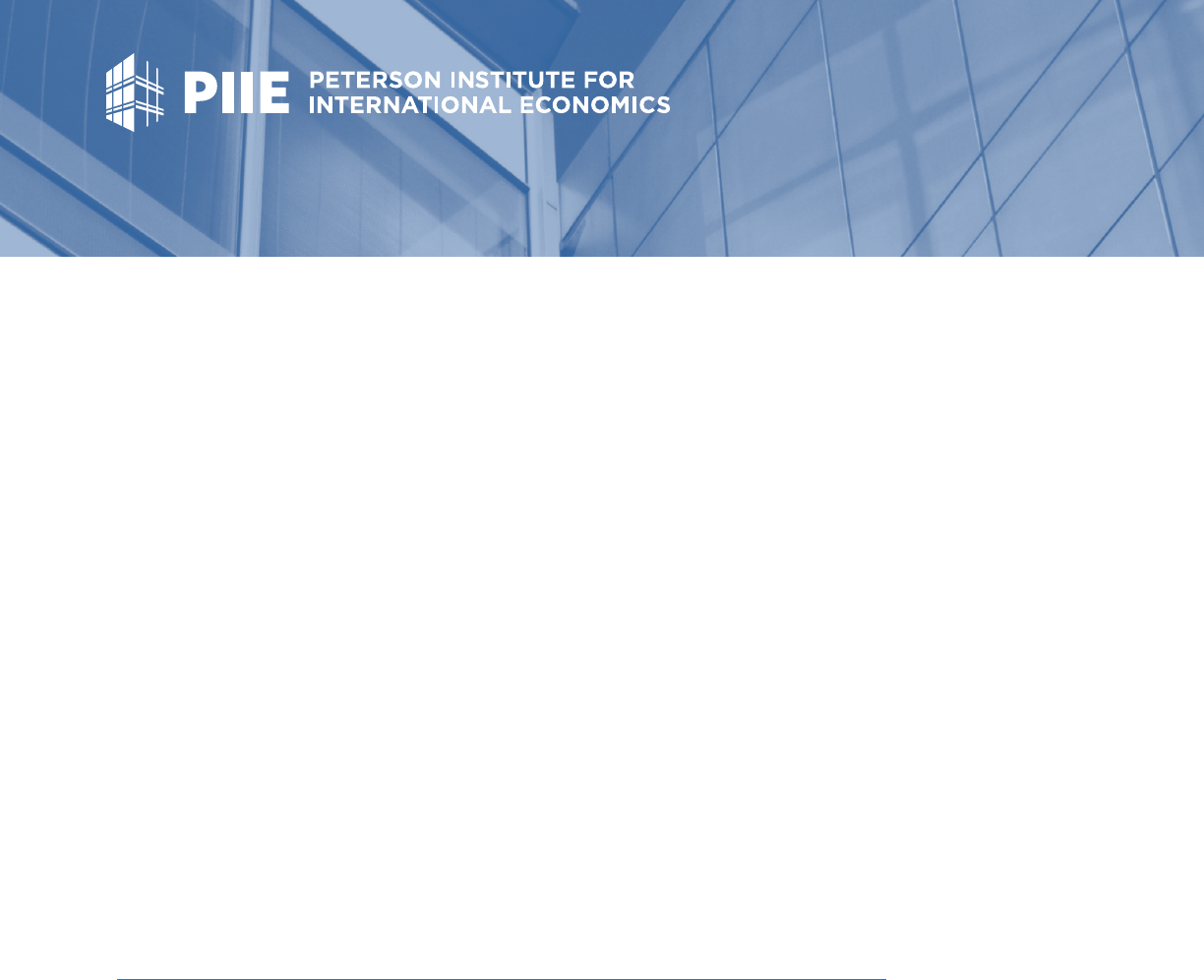
© 2024 Peterson Institute for International Economics. All rights reserved.
This publication has been subjected to a prepublication peer review intended to ensure
analytical quality. The views expressed are those of the author. This publication is part
ofthe overall program of the Peterson Institute for International Economics, as endorsed
byits Board of Directors, but it does not necessarily reflect the views of individual
membersof the Board or of the Institute’s sta or management.
The Peterson Institute for International Economics is a private nonpartisan, nonprofit
institution for rigorous, intellectually open, and indepth study and discussion of
international economic policy. Its purpose is to identify and analyze important issues to
make globalization beneficial and sustainable for the people of the United States and the
world, and then to develop and communicate practical new approaches for dealing with
them. Its work is funded by a highly diverse group of philanthropic foundations, private
corporations, and interested individuals, as well as income on its capital fund. About
14percent of the Institute’s resources in its latest fiscal year were provided by contributors
from outside the United States.
A list of all financial supporters is posted at
https://piie.com/sites/default/files/supporters.pdf.
